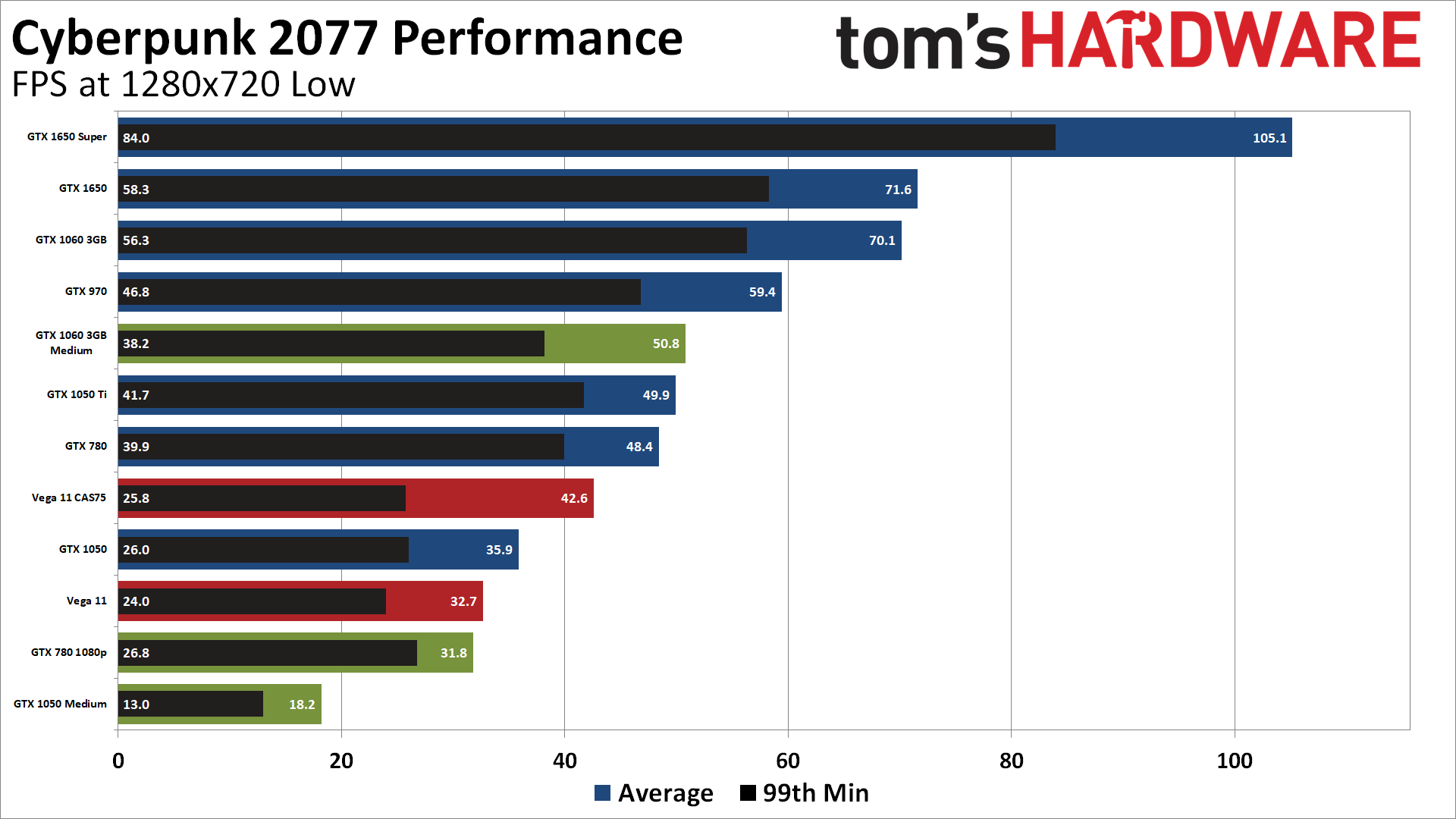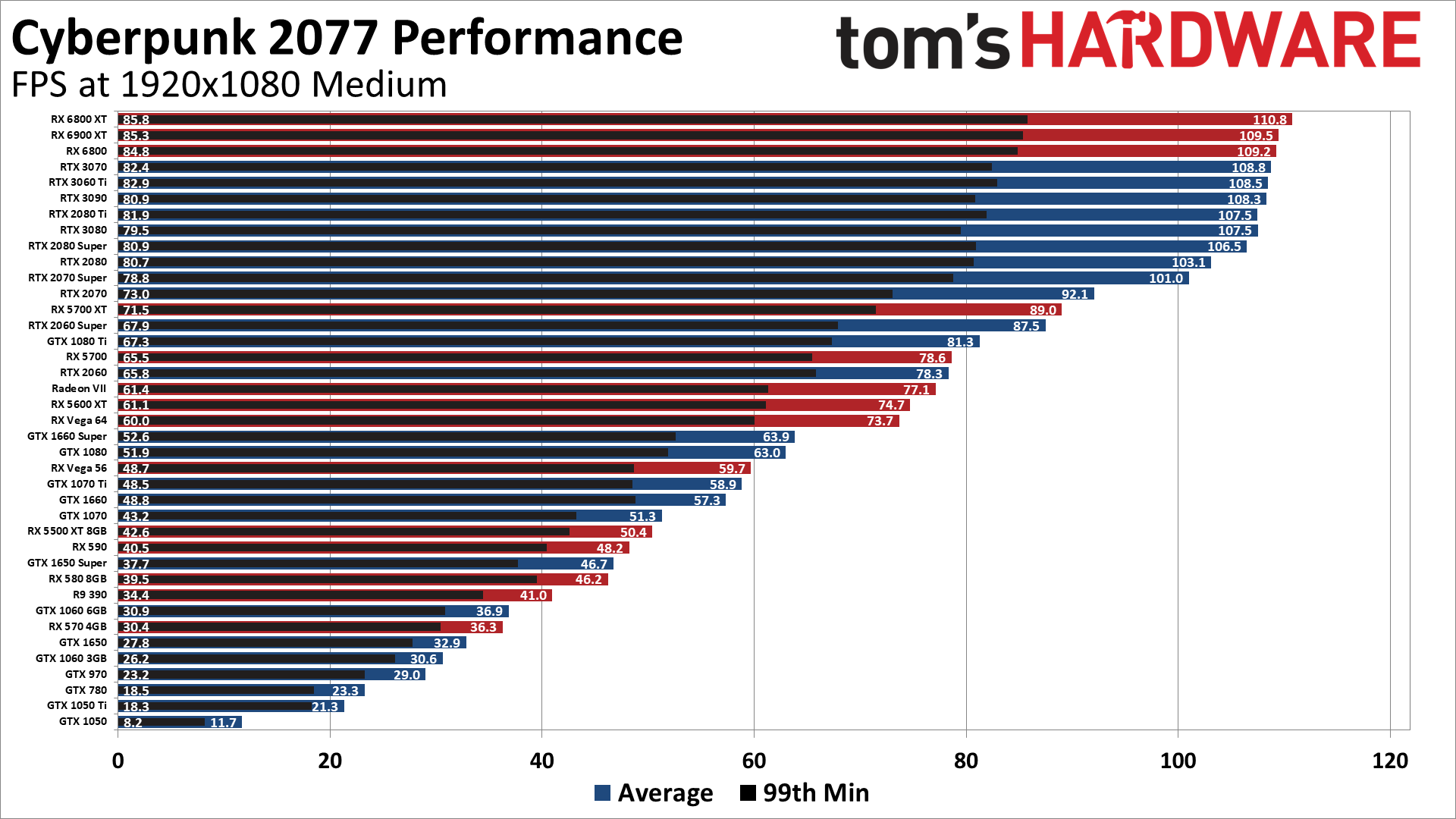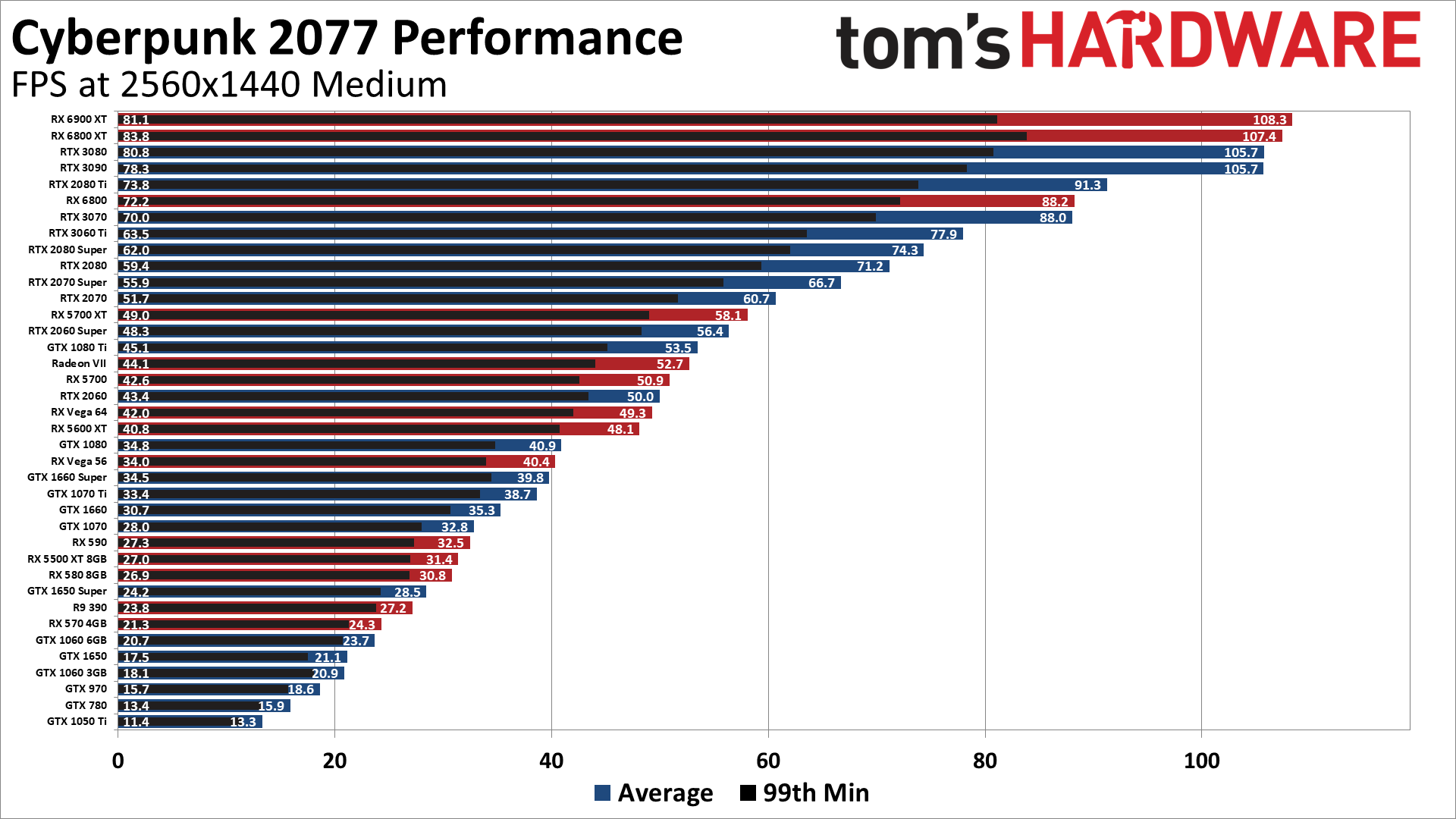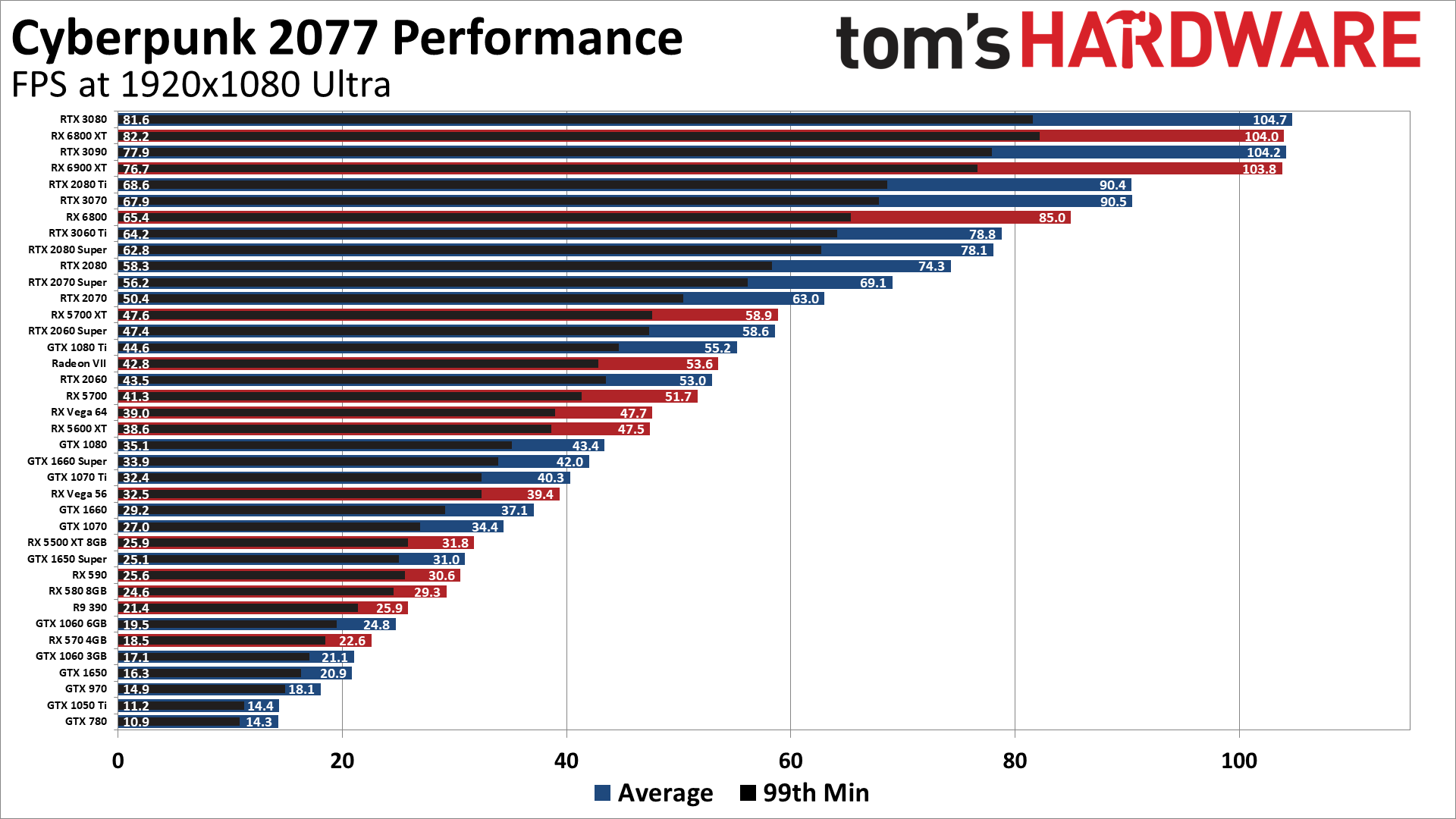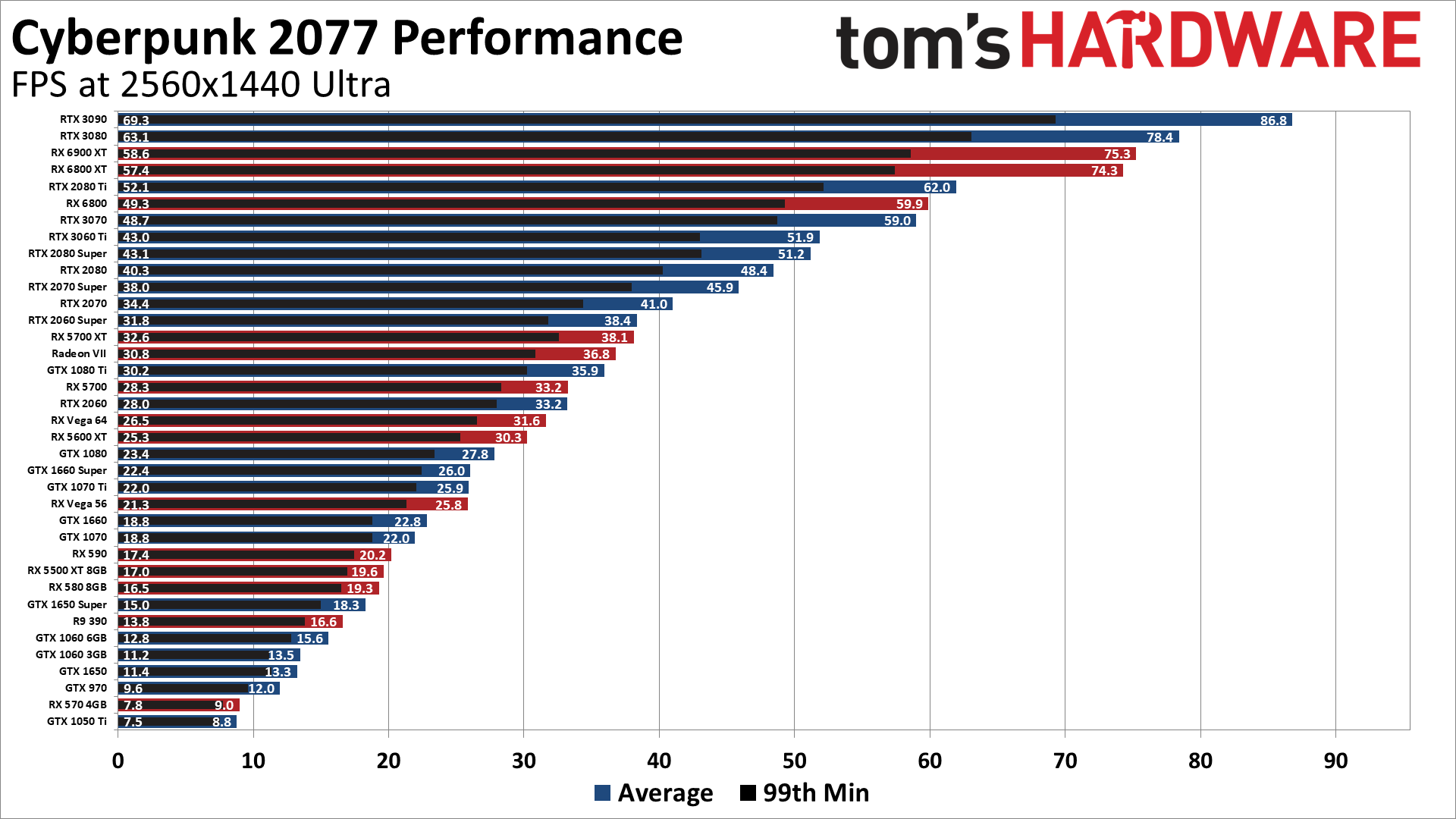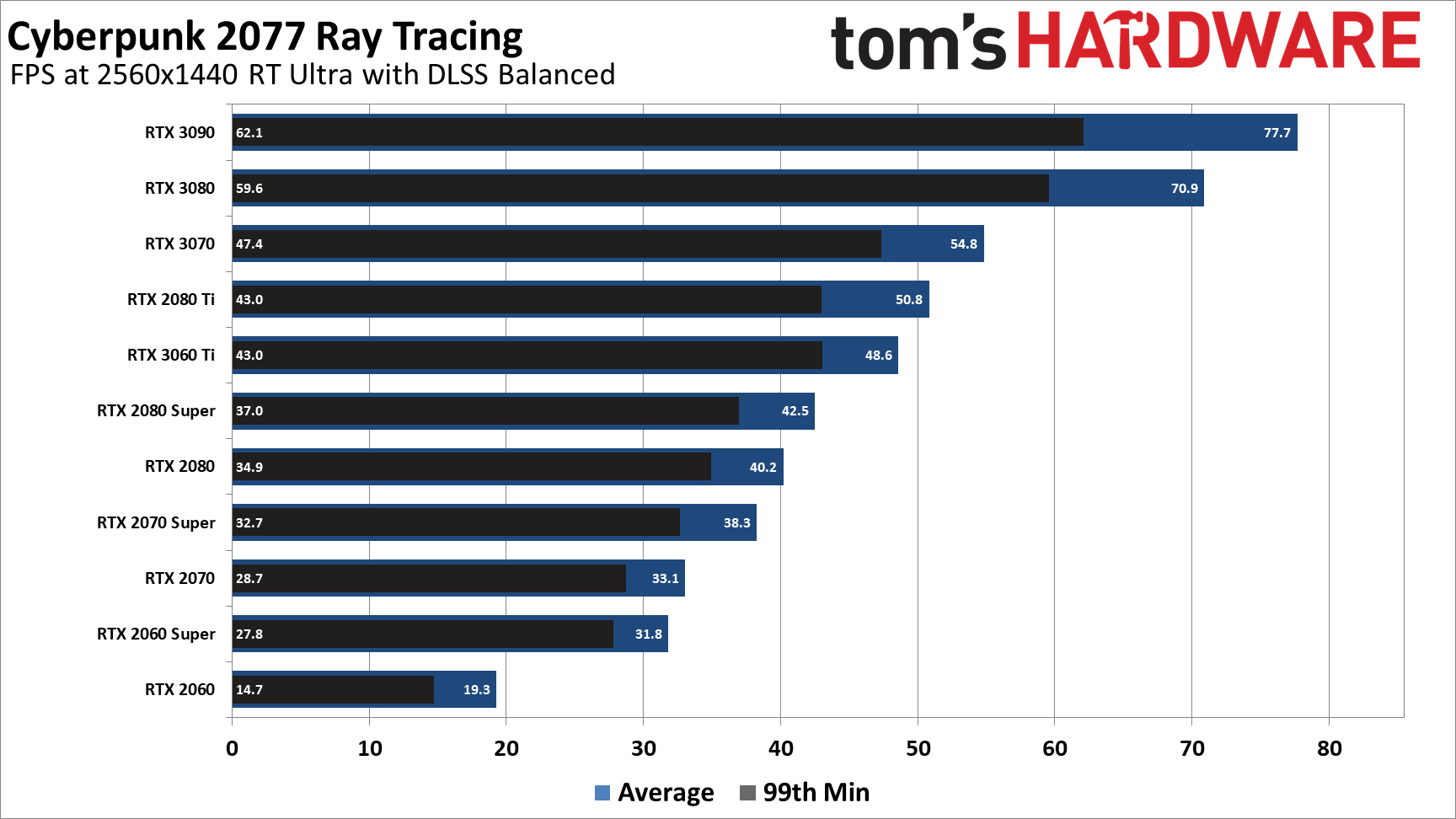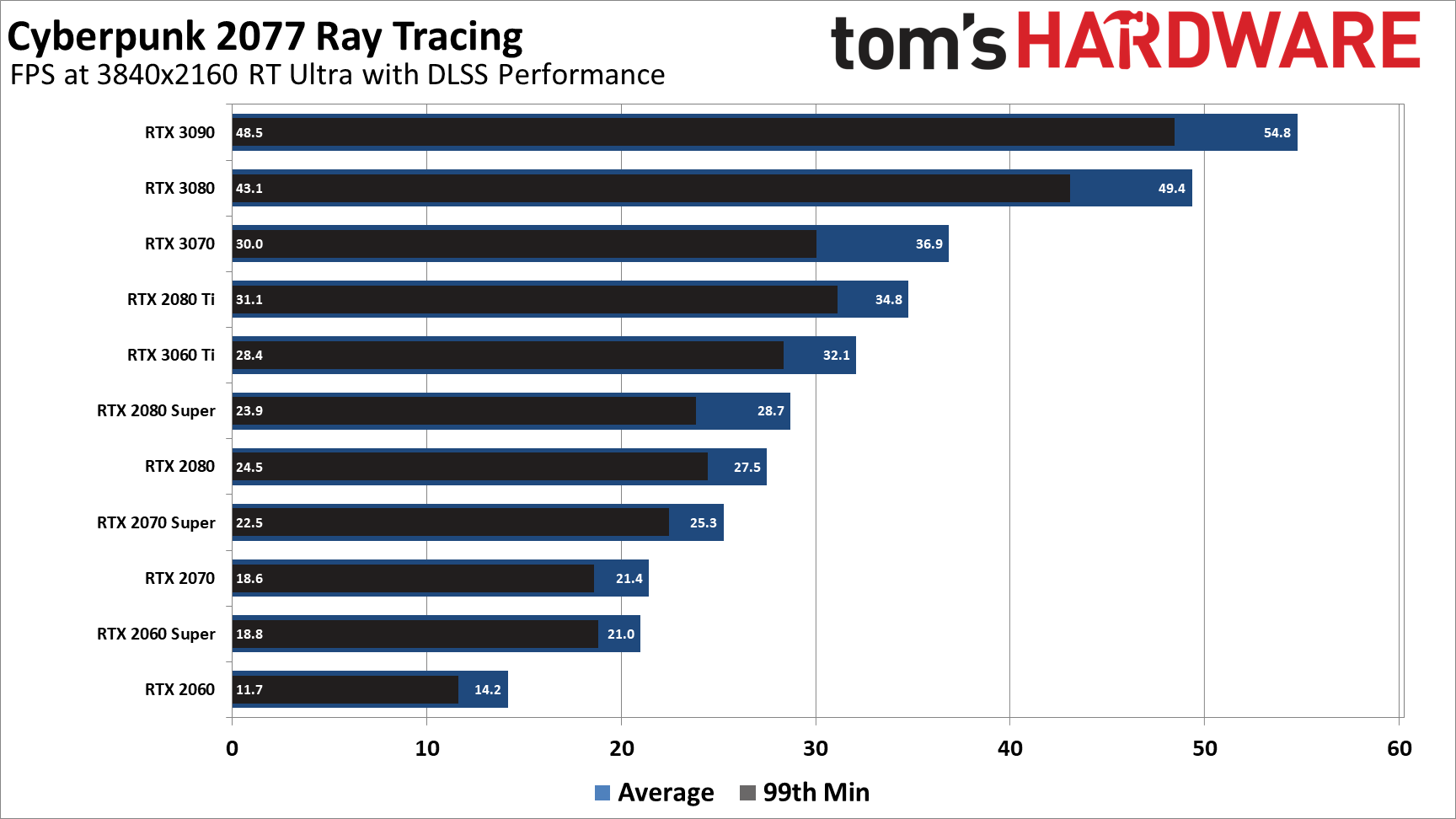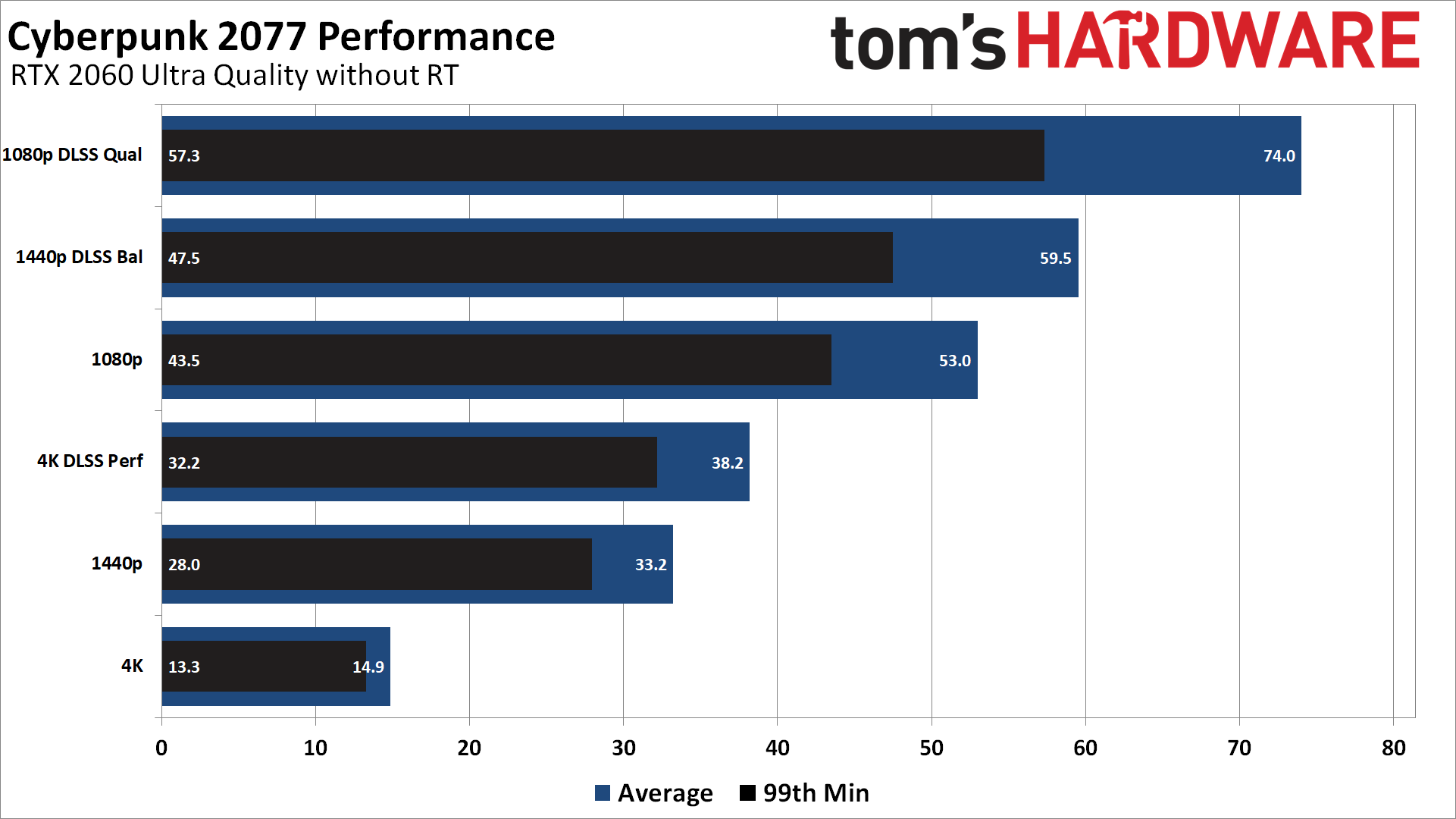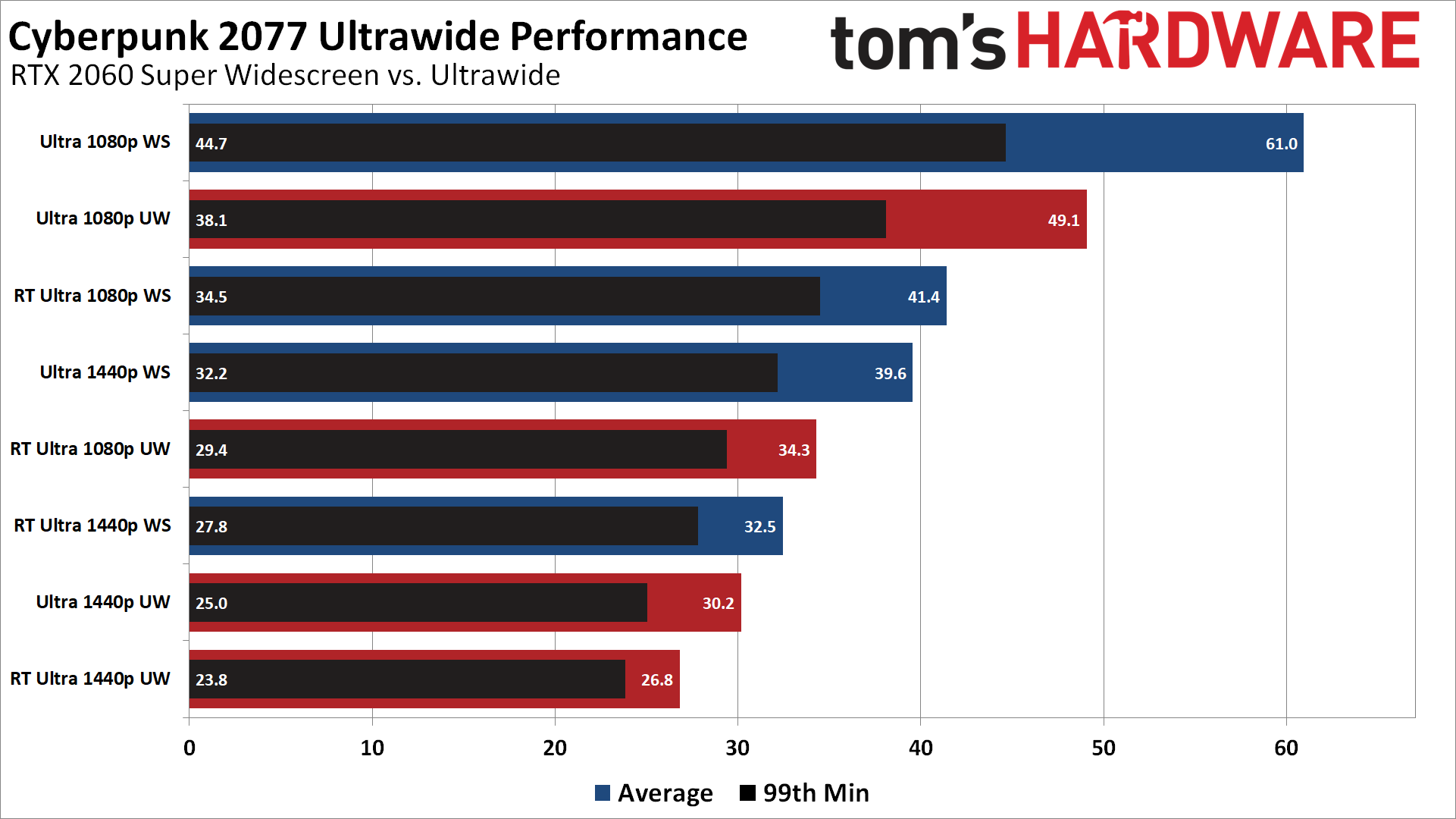Cyberpunk 2077 PC Benchmarks, Settings, and Performance Analysis
We've tested Cyberpunk 2077 on a bunch of GPUs to see how it runs. Spoiler: It's very demanding.
Cyberpunk 2077 is finally here. After years of waiting, one of the most anticipated games ever (in my book, anyway) has arrived. With the game now in its final form and ready for play, naturally, we want to run benchmarks to see how the game actually performs on a variety of hardware. Specifically, we've tested Cyberpunk 2077 on 40 different GPUs from the past five generations of hardware. It's not every possible GPU, but all of the latest gen and previous gen, plus plenty more.
With the long wait out of the way, we can finally put some actual numbers to the official Cyberpunk 2077 system requirements. The minimum GPU listed is a GTX 780, with GTX 1060 6GB recommended for 1080p high, RTX 2060 for 1440p ultra, and an RTX 2080 Super for 4K ultra. Then there's the ray tracing additions, with the RTX 2060 listed as the minimum for 1080p and RT medium, 3070 for 1440p and RT ultra, and 3080 for 4K RT ultra. Developer CD Projekt Red never stated what sort of performance players should expect from that hardware, but it looks like 30-40 fps for the lower end GPUs, and typically less than 60 fps even at the high end.
We posted some initial impressions of Cyberpunk 2077 prior to the public launch, but that was with pre-release code that was not yet fully optimized, plus it contained anti-piracy software Denuvo. However, based on our updated benchmarks, performance hasn't improved much with the release code and updated drivers. We're typically seeing about a 5 percent increase in performance, at best. If you're after smooth 60 fps performance, you're going to need to aim quite a bit higher than the suggested hardware.
We can say that the game is very playable at 30-60 fps on PC. Gunfights can be a bit more difficult if you're at the lower end of that range, but if you've played another shooter at 30-60 fps, Cyberpunk 2077 shouldn't pose any problems. It's not a fast-paced shooter by any stretch, and there are often other alternatives to shooting. Still, going from 30-40 fps up to 60+ fps makes for a much nicer experience overall.

Cyberpunk 2077 Performance Test Setup
Main PC:
Intel Core i9-9900K
MSI MEG Z390 Ace
Corsair 2x16GB DDR4-3600 CL16
XPG SX8200 Pro 2TB
Seasonic Focus 850 Platinum
Corsair Hydro H150i Pro RGB
Phanteks Enthoo Pro M
GPUs:
GeForce RTX 3090
GeForce RTX 3080
GeForce RTX 3070
GeForce RTX 3060 Ti
Radeon RX 6900 XT
Radeon RX 6800 XT
Radeon RX 6800
...And many more!
We're playing the game with our standard GPU testbed as usual (specs to the right), which is very much over-spec in terms of what Cyberpunk 2077 requires. We've got twice the memory and twice the CPU cores, more or less, with a massive collection of GPUs that we've tested.
We're also working on some CPU scaling tests, but with the preview code, we disabled half of the CPU cores on our Core i9-9900K to simulate a Core i7-7700K. It's technically clocked a bit higher and has more L3 cache, and we only tested with the RTX 3090. The extra cores boosted performance at lower resolutions by up to 25 percent, and more importantly, managed to consistently stay above 60 fps (provided the GPU was up to snuff). If you have an older CPU, particularly a 4-core/4-thread CPU like the 7th Gen and earlier Core i5 chips, you should set your expectations accordingly.
Currently, owners of AMD's new RX 6000 series graphics cards are locked out of ray tracing, but support will come post-launch. The preview version of the game initially let us try to enable ray tracing on AMD's cards, but enabling RT reflections caused an immediate crash. The other RT effects didn't necessarily work properly, either. Hopefully this gets addressed quickly post-launch.
Get Tom's Hardware's best news and in-depth reviews, straight to your inbox.
Cyberpunk 2077 Settings Overview


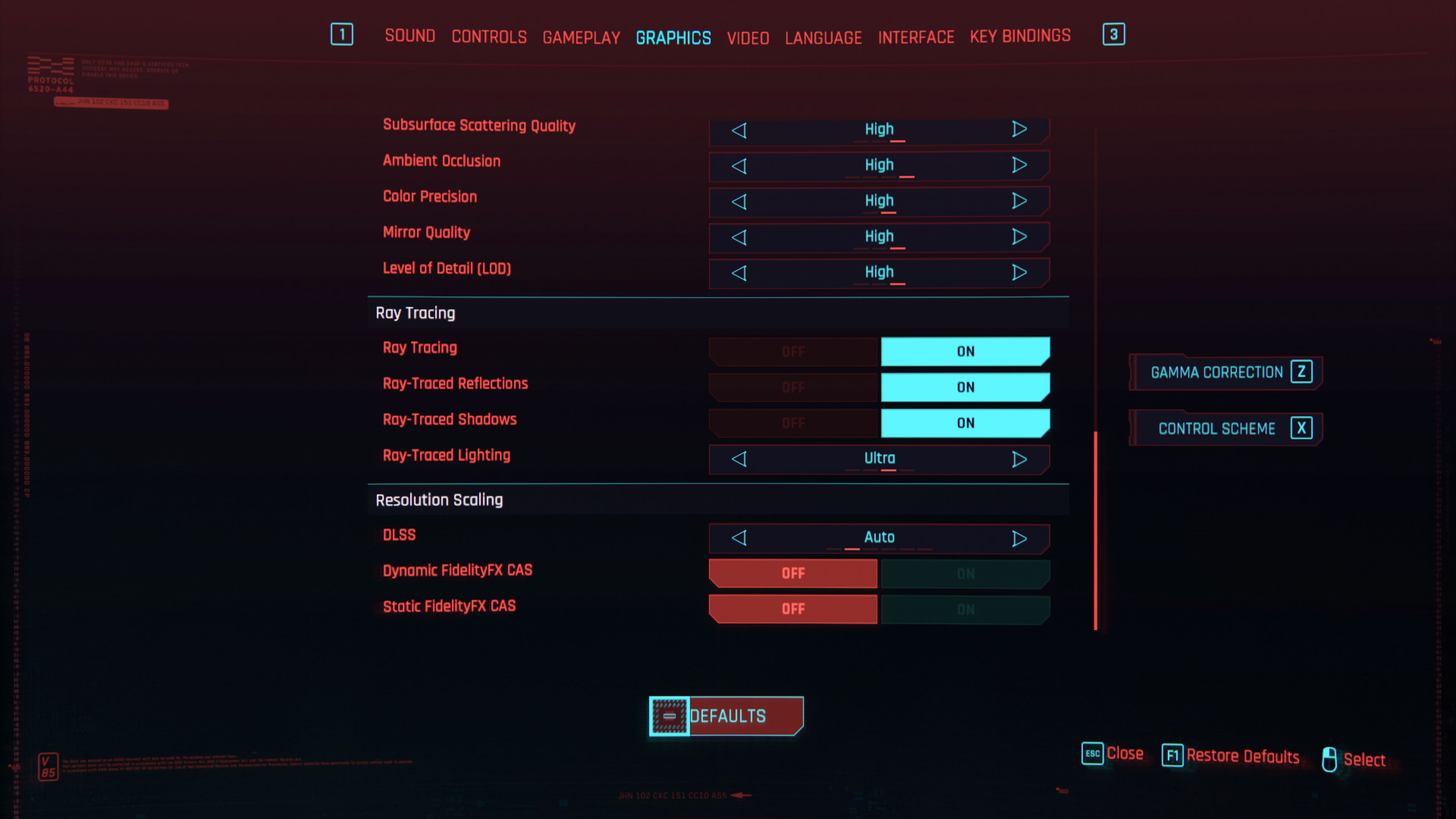
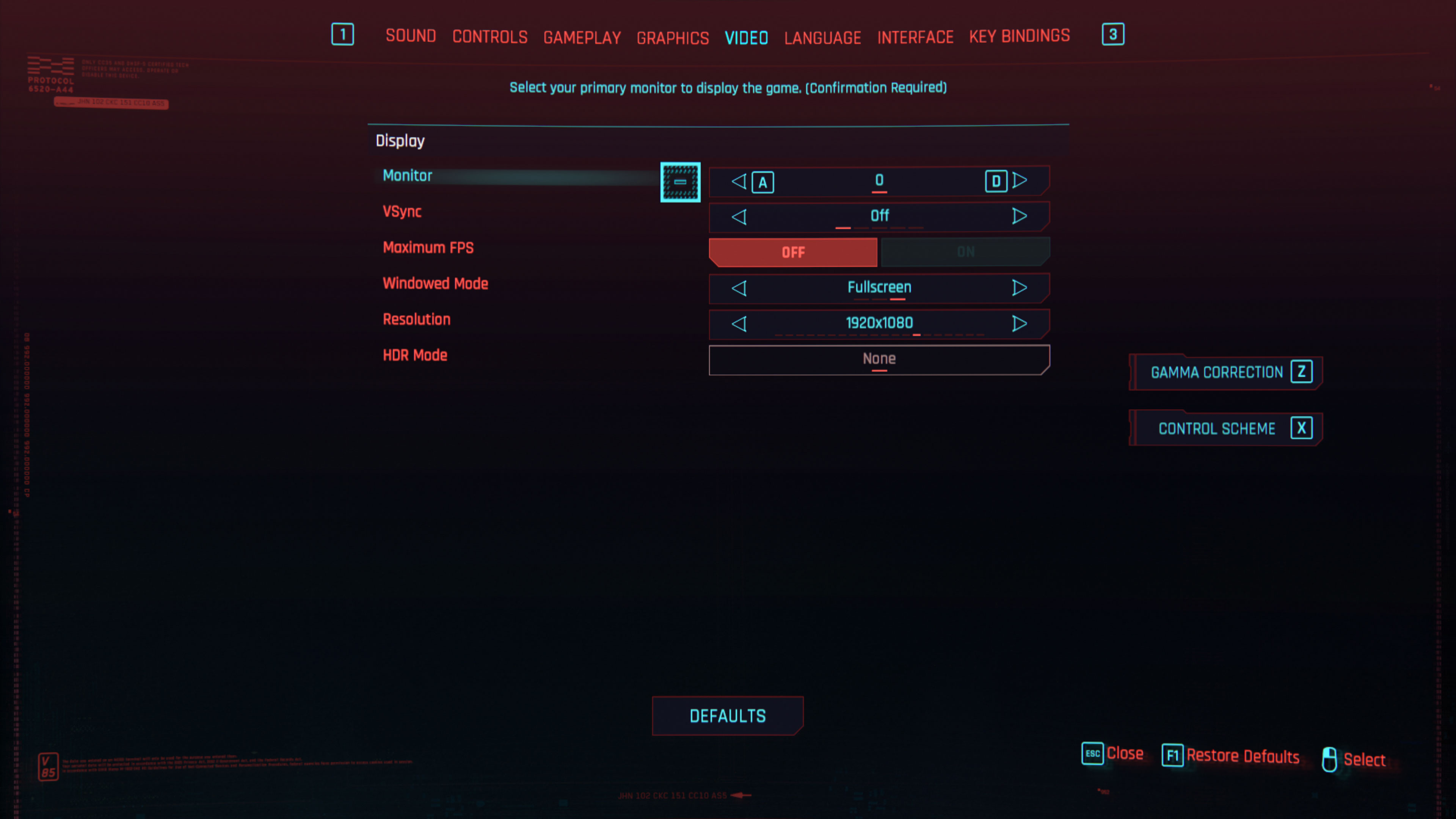
There are approximately 24 different graphics settings you can tweak and tune in Cyberpunk 2077, which is a lot. However, we're seeing relatively limited scaling in going from minimum to maximum quality. Resolution and resolution scaling have the biggest effect on performance, and beyond that, only a handful of settings seem to matter.
If you're hoping to improve framerates without resorting to the low or medium presets, your best bet is to start with dropping the Screen Space Reflections Quality to medium or even off. Based on our testing, that will improve performance by 10-15 percent. Volumetric Fog Resolution has the next biggest impact on performance, and dropping to low should add another 10-15 percent to your fps.
Depending on your hardware, turning Crowd Density down to low can also boost performance by 10 percent or so. I tends to make the city look a bit more like a ghost town, though, and seems to be at least somewhat linked with your CPU's power. If you have a relatively low-end CPU, the improvement in performance might be even larger.
Beyond those three settings, finding ways to boost performance becomes a bit more difficult. All of the shadows-related settings combined (Local Shadow Mesh and Quality, Cascaded Shadows Resolution and Range, Distant Shadows Resolution, and Ambient Occlusion) are only good for another 10-15 percent. And if you drop everything else to minimum (stuff like Film Grain, Depth of Field, Motion Blur, Anisotropy, and Level of Detail), you only get about another 10 percent.
Resolution: 2560x1440
Crowd Density: High (or not)
Film Grain: On/Off (your choice)
Chromatic Aberration: Off (it's terrible)
Depth of Field: On/Off
Lens Flare: On
Motion Blur: Off (I don't like it)
Contact Shadows: On
Improved Facial Lighting: On
Anisotropy: 4
Local Shadow Mesh Qual: High
Local Shadow Quality: Medium
Cascaded Shadows Range: High
Cascaded Shadows Res: Medium
Distant Shadows Res: High
Volumetric Fog Resolution: Medium
Volumetric Cloud Quality: Medium
Max Dynamic Decals: Ultra
SSR Quality: N/A (RT Reflections)
Subsurface Scattering Quality: High
Ambient Occlusion: N/A (RT Lighting)
Color Precision: High
Mirror Quality: High
Level of Detail: High
Ray Tracing: On
Ray-Traced Reflections: On
Ray-Traced Shadows: Off
Ray Traced Lighting: Medium
DLSS: Quality
Also, and this is critical: Turn off Chromatic Aberration, because it makes the game look incredibly blurry. Seriously, it's terrible. It doesn't hurt performance as such, but the setting is on by default with the Ultra and above presets, and often makes the game look worse than when running at a lower setting.
If you want to go the other way, turning on all the ray tracing extras via the RT Ultra preset, with DLSS turned off, cuts performance in half — actually a bit more than half, unless you're running at 1080p on an RTX 3080 or 3090. Are all the RT effects worth the performance hit? We'd say so, provided you have a high-end RTX GPU, but you can certainly enjoy Cyberpunk 2077 without them.
The good news is that DLSS can recover a decent amount of performance if you have an RTX card (and you can use it without ray tracing if you want). DLSS Quality mode is good for around 40-60 percent more performance, and DLSS Balanced mode nearly doubled our performance at 1440p using the RT Ultra preset. DLSS Performance mode is mostly for 4K (or higher) resolutions and can more than double your fps compared to native.
For non-RTX GPU owners, the game's release version also has new FidelityFX CAS options for resolution scaling. The dynamic mode can adjust the scaling on the fly to try to hit your target framerate, while static scaling applies a set scaling factor. If you run at 4K with a static 50 percent scaling, the game renders at 1080p and uses FidelityFX to upscale the result, and then the UI elements are rendered at 4K. It's actually not a bad way to do things, though DLSS does look better overall.
If you check out our recommended settings to the right, we averaged around 70 fps on an RTX 3080 at 1440p using those. It's worth noting that Screen Space Reflections Quality overlaps with RT Reflections, and Ambient Occlusion is superfluous if you've enabled RT Lighting. Disabling (or enabling) these has no impact on performance when using the ray tracing alternatives. Disabling RT and putting AO on high and SSR on medium, the same settings yielded over 100 fps, or 75 fps at 4K.
Cyberpunk 2077 GPU Benchmarks
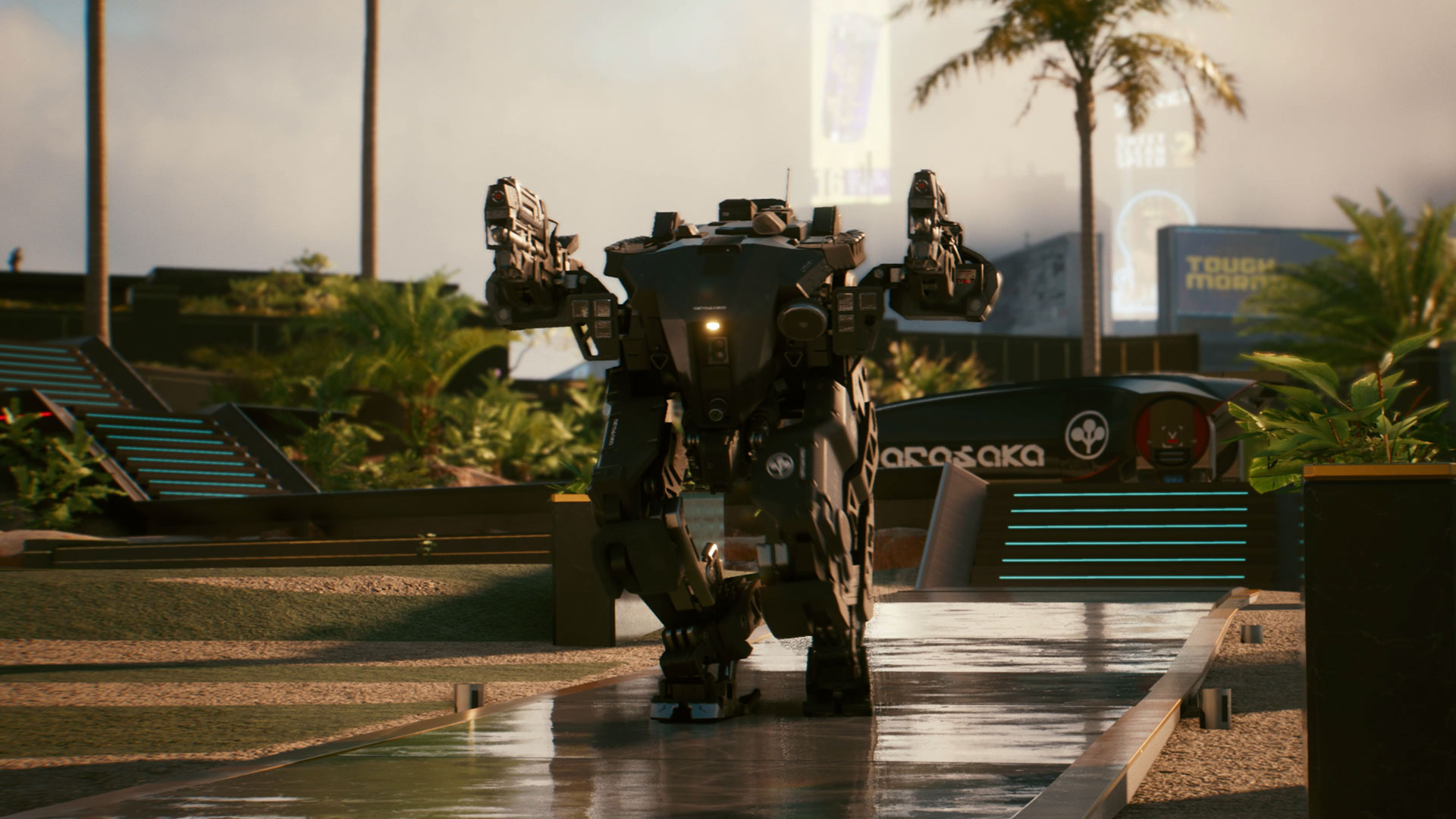
So how does Cyberpunk 2077 run? Depending on your hardware and expectations, it either runs surprisingly well, or it runs like a turtle climbing up a steep hill. Maxed out quality on an RTX 20-series card, at 4K, without DLSS? That's the turtle. Old cards like the GTX 780 or lower GTX 10-series GPUs? Also tortoise-like.
We'll get to the image quality comparisons below to show how the game looks, but one thing to keep in mind is that Night City is very impressive to look at and run or drive around in. There's a full day/night cycle; you can start at one end of the city and run or drive through the whole maze without ever encountering a loading screen. Fast travel does cause a loading screen, of course, but that's because you effectively teleport to a new location, and there's no opportunity to dynamically load elements as you travel.
All of that makes for a demanding game engine. The crowds also contribute to a drop in performance, but add quite a bit of ambience (even if most of the people roaming around do nothing). Turn on all the ray tracing effects, and Night City looks even more impressive, with reflective surfaces and (relatively) accurate lighting and shadows.
As you'd expect, maxing out the settings requires a pretty potent rig, particularly on the GPU side of things. At 1080p with Nvidia's DLSS Quality mode enabled, the GeForce RTX 3080 cruises along at 80 fps. An RTX 2060, though? It can't quite hit 60 fps even with DLSS Performance mode (though a bit of tuning can get it there). But enough talk, let's hit the benchmarks.

Our test is simple: We start near the entrance to V's apartment complex, down on the ground floor. Then we walk down the stairs, cross the street to the left, cross the next street to the right, and head off toward Tom's Diner. Turn left in front of the diner, across another street and up the stairs, and past the two cops talking to some irritated civilians. "But when the Tygers come around, you ain't nowhere to be found!" (I may have walked this path too many times.)
Basically, we're just taking a stroll through the city. We're using the medium and ultra presets for now, with texture quality and crowd density at high. Each GPU gets tested twice at each setting, plus an extra run at the start to warm up the card. We don't restart the game between resolution changes (unless it crashes, which has happened a few times), but we do restart when switching from the Medium to the Ultra preset. (It makes about a 3 percent difference.)
There are certainly more demanding areas of the game, and less demanding areas as well. But most of the Night City outdoor environments seem to perform within about a 20 percent range, and you'll spend plenty of time outdoors. Driving can make things run even slower, but we opted not to hop in a vehicle as you can't do much other than drive. There's no way to shoot (unless you're the passenger in a scripted on-rails sequence).
We've tested just about every GPU in our possession right now. If we've missed one you'd like to see, let us know in the comments. The charts are already crowded, so what's one or two more entries? Note that we used version 1.03 for most of the testing, but version 1.04 went live for the last eight or so GPUs. We only did very limited testing of 1.04 compared to 1.03, and it looks like performance hasn't really changed as 1.04 is primarily focused on stability and bug squashing. Anyway, here's how things stand so far.
Here's 720p running at minimum quality, for those with a low-end GPU that only has 2GB or maybe 3GB of VRAM, or who are using integrated graphics. You'll see in a moment why we tested cards like the GTX 1050 at 720p and minimum quality, and we tossed in a few other lower-tier GPUs for good measure. The green results are for either 720p with the medium preset (high textures and crowd density), or 1080p with the minimum settings (for the GTX 780).
AMD's Vega 11 running on a Ryzen 5 2400G reaches (barely) playable levels. It's nowhere near powerful enough to handle 1080p at medium quality, but 720p at minimum quality averages 33 fps. The CPU most likely is struggling a bit, leading to minimums of 24 fps, but you could play Cyberpunk 2077 this way in a pinch. We also enabled FidelityFX CAS with 75 percent static scaling, which boosted the average fps to 43 (but minimums are still only 26 fps).
What about Intel integrated graphics? We tried to get the game to run on a Tiger Lake laptop with a Core i7-1165G7 and Xe Graphics. It didn't go so well. The game crashed while trying to start up every single time. We tried tweaking the configuration file but had no success taking that route as well, as nearly all of the settings are directly accessible in the game (not that we could even launch the game). UHD Graphics 630 was a similar story. Maybe updated drivers will get the game to at least run, but we'd expect the resulting performance to be worse than the Vega 11.
If you saw our performance preview and were hoping things would radically improve, we've got bad news: Cyberpunk 2077 is every bit as demanding as we showed before. At the medium preset, the GTX 1660 Super just barely manages 60 fps, and that's a big step up from the minimum GTX 780 GPU listed in the official system requirements. Something else worth pointing out is that the GTX 1660 Super basically ties or beats the GTX 1080. That's a first, but it shows how the latest games tend to benefit from newer architectures.
The formerly mighty GTX 1080 Ti gets 81 fps, which is great, but it drops off quickly at higher resolutions. The previous high-end / mainstream GTX 1070 meanwhile checks in at a paltry 51 fps, and goes down from there. Yes, the 1070 is effectively down near the budget ranked GPUs, at least in this particularly game. And the "recommended" for 1080p high GTX 1060 6GB? Well, it can do 37 fps at medium settings, which means pretty close to 30 fps at high settings. (A bit of dynamic resolution scaling can get it the rest of the way there if needed.)
At 1440p, the RX 5700 XT and 1080 Ti can't hit 60 fps. Only the 2070 Super and above (of the tested cards) can do that, though we're CPU limited to around 105-110 fps at the medium preset. Lastly, at 4K medium, only the top four GPUs break 60 fps, which pretty much means nothing else will do so without resolution scaling (either DLSS or FidelityFX).
What about older hardware, though? We're not at 1080p low, which helps quite a bit if you're willing to go that far (see the GTX 780 1080p min results in the 720p Low chart), but the GTX 970 only puts up a result of 29 fps at medium quality. You'll need to use FidelityFX upscaling or drop to a lower setting or resolution just to get 30 fps from that card.
Kicking things up to ultra quality drops performance by around 35 percent on the slower GPUs at 1080p, and just about all of the GPUs we've tested lose 20 percent or more at 1440p ultra. The GTX 1070 sits in the bottom third of our charts, and 34 fps at 1080p ultra probably wasn't what most people were hoping to see. RX 590, GTX 1650 Super, and RX 5500 XT 8GB also barely clear 30 fps.
AMD's latest RDNA2 GPUs did quite well at medium quality, but the move to ultra quality puts the 3080 and 3090 at the top of the charts. It's probably just a matter of memory bandwidth, especially at 1440p and 4K. There's only so much a large L3 cache can do before the GPU simply needs a wider and faster memory interface, and GDDR6X provides that on Nvidia's 3080 and 3090.
Anyway, running 4K ultra at native resolution means 60 fps just isn't happening, sorry. The mighty RTX 3090 gets 46.7 fps with the release version of Cyberpunk 2077, running the latest Nvidia 460.79 drivers. For the record, that's two whole percent faster than what we saw with the preview build running the slightly older 457.51 drivers — much ado about nothing.
We weren't really expecting massive improvements in just an extra week or two of testing, and honestly, the janky aspects of Night City are far more of a concern right now than performance. You can easily drop the settings a few notches to try and boost performance, but that doesn't solve the issues of teleporting people, clipping, missions not progressing, and more.
Plus, as you'll see below with the image quality comparisons, even the low and medium presets still look good. The biggest difference you're likely to notice is the lack of shadows and ambient occlusion if you have those turned all the way down.
Cyberpunk 2077 Ray Tracing and DLSS Performance
What about running with the (nearly) maxed out RT Ultra settings? We can only test on Nvidia RTX cards, at least for now, and since we're going with the RT Ultra preset we're also going to run with DLSS enabled. We'll use DLSS Quality at 1080p, DLSS Balanced at 1440p, and DLSS Performance at 4K. (These are also the values used for DLSS Auto, as far as we can tell, but we're explicitly setting the DLSS mode just to be sure. We wouldn't want to test a 3090 with DLSS Quality and compare it with a 2080 Ti and DLSS Balanced at the 'same' resolution.)
The RTX 3090, 3080 and 3070 can handle 1080p, while only the first two break 60 fps at 1440p. 4K RT Ultra? Not so much. Even with DLSS Performance mode, the 3090 averaged just 55 fps. And to be clear, DLSS Performance mode definitely results in a lower overall image quality.
55 fps isn't terrible, especially if you have a G-Sync capable display, but if you're thinking the fastest current GPU on the planet should run every game at 4K and maxed out settings, that's not going to happen. There are other games where the 3090 can't quite hit 60 fps as well, like Fortnite with maxed out RT settings. Usually DLSS Performance mode can get it there if it's an option, but the most demanding ray tracing games can still punish even the fastest GPUs.
Looking elsewhere, the RTX 2070 Super results are pretty sobering. 49 fps at 1080p and 38 fps at 1440p with DLSS enabled is playable, but only just. 4K even with DLSS isn't happening. You'd probably enjoy the game more at the Ultra preset (without RT enabled) using DLSS, as it will run much better. At least the 2080 Ti still manages to stay ahead of the 3060 Ti, though not by much.
The RTX 2060 meanwhile really isn't cut out for handling the RT Ultra preset. Which, to be fair, Nvidia and CD Projekt Red never suggested it could. It's recommended for 1080p RT Medium, which should push it above 30 fps based on our other testing. Or you could try turning down Volumetric Fog, Crowd Density, and Screen Space Reflections a notch or two and that may suffice to get 30+ fps with the 2060. Oh, and disable the blurtastic Chromatic Aberration if you missed that note earlier.
If you don't have an RTX card, you can forget about ray tracing. Actually, you can try to run RT Ultra with a GTX 16-series GPU that has at least 6GB of RAM. We did that with the GTX 1660 Super, at 720p, with FidelityFX set to a static 50 percent rendering resolution. And it worked! We got all the ray traced reflections, shadows, and lighting... at 34 fps. It was also hella blurry and not recommended. RTX hardware is needed, or at least RX 6000 once it gets RT support from the game (probably with FidelityFX scaling).
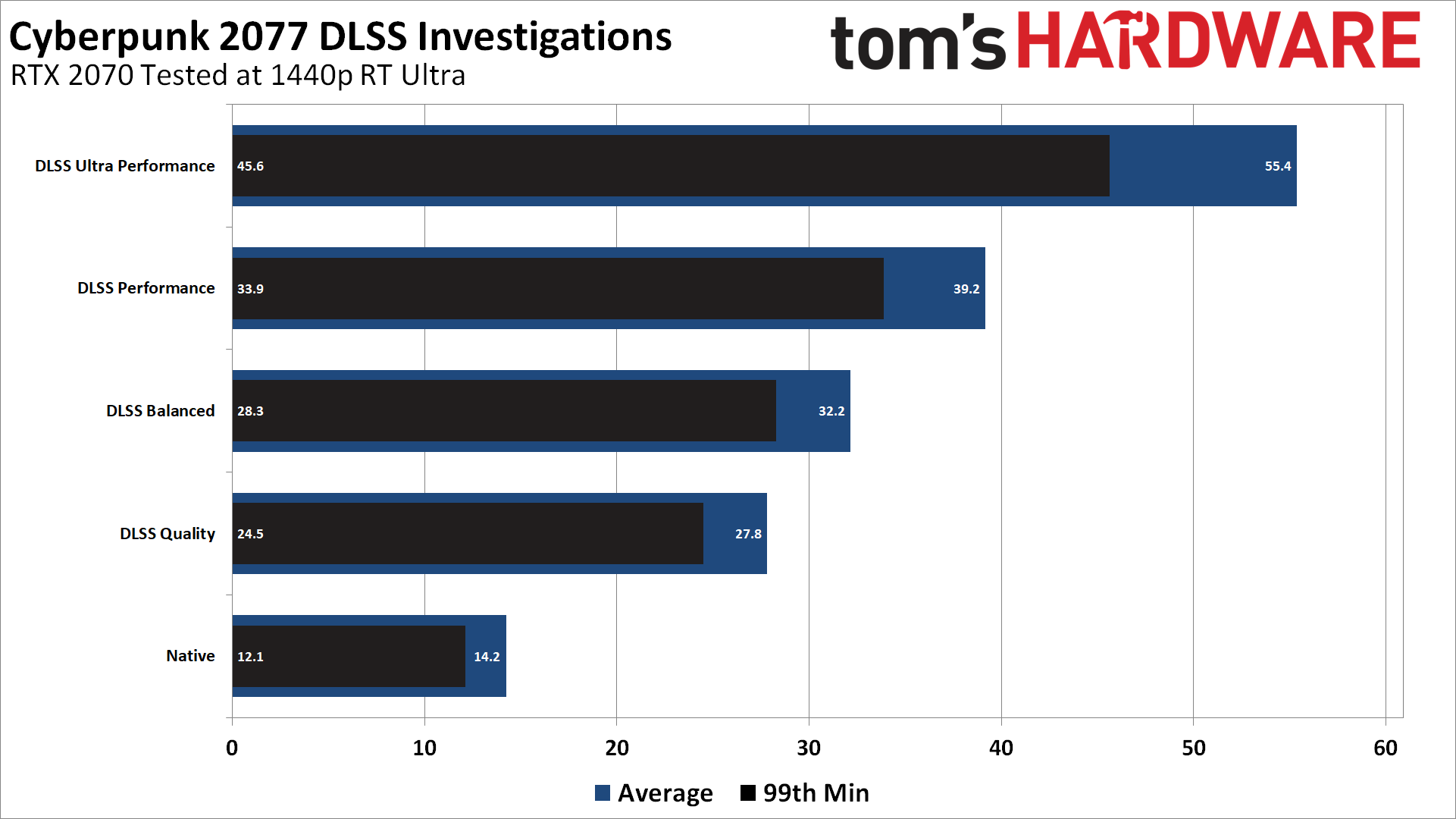
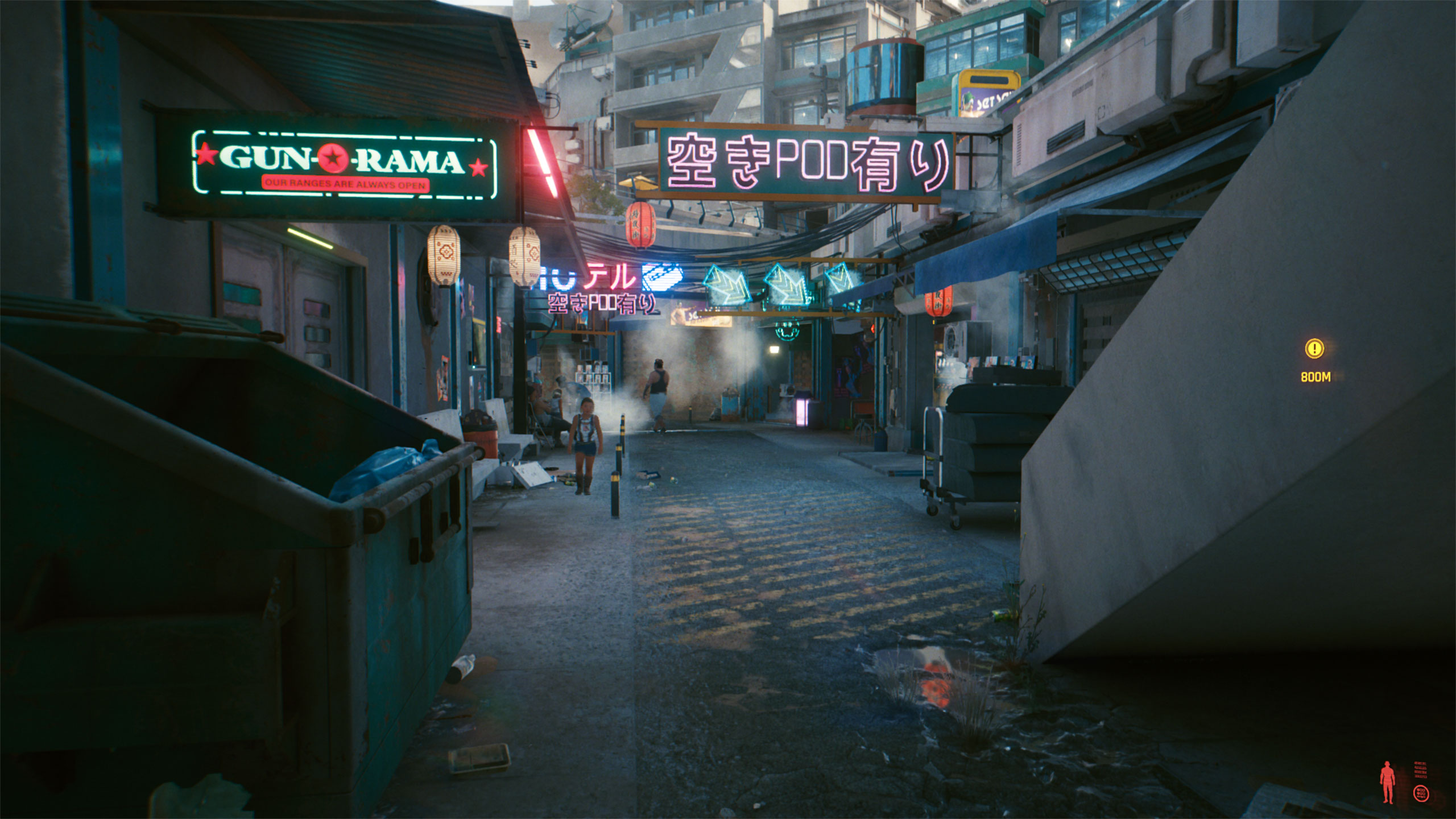
1440p RT Ultra, Native (no DLSS)
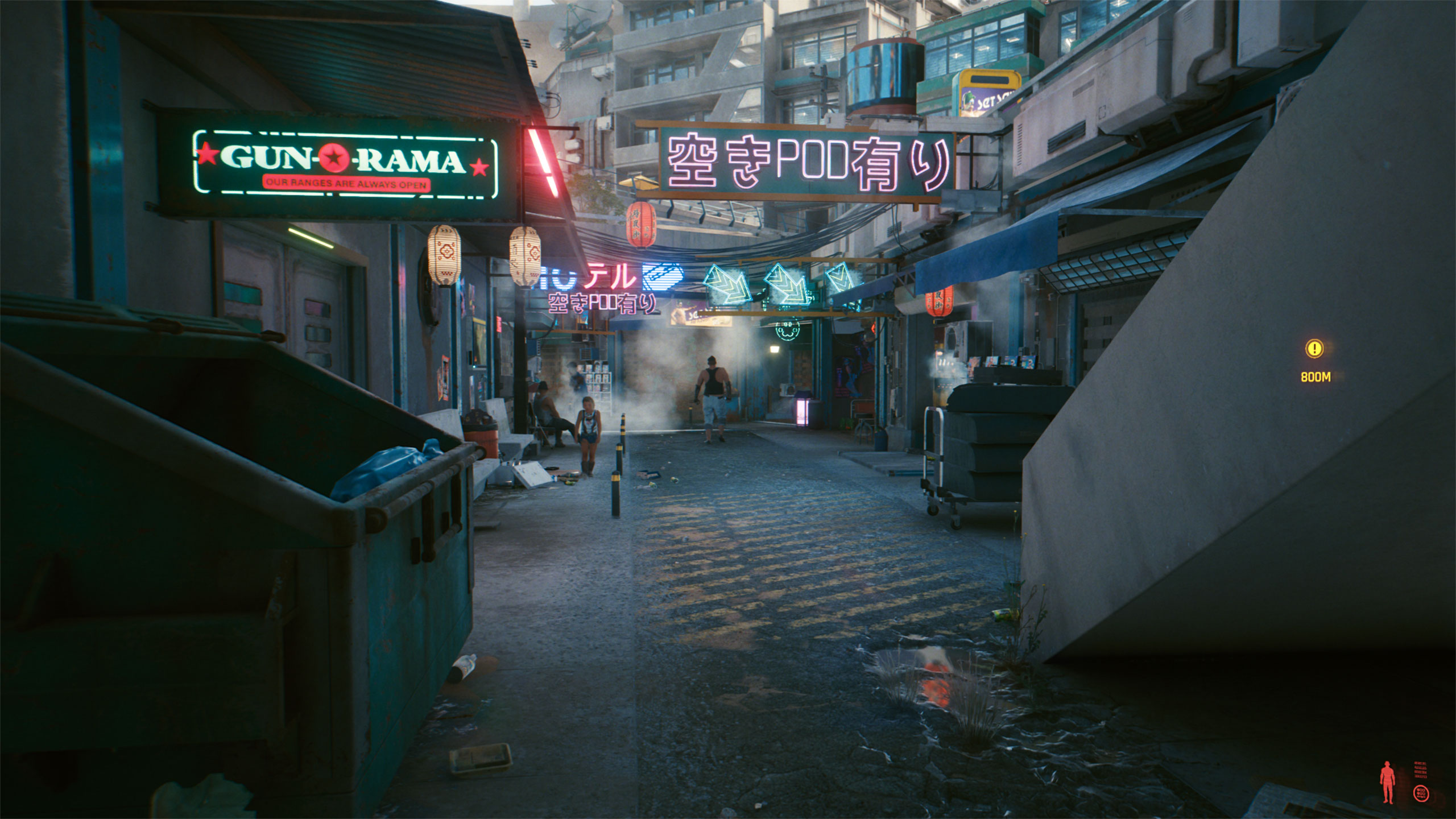
1440p RT Ultra, DLSS Quality

1440p RT Ultra, DLSS Balanced
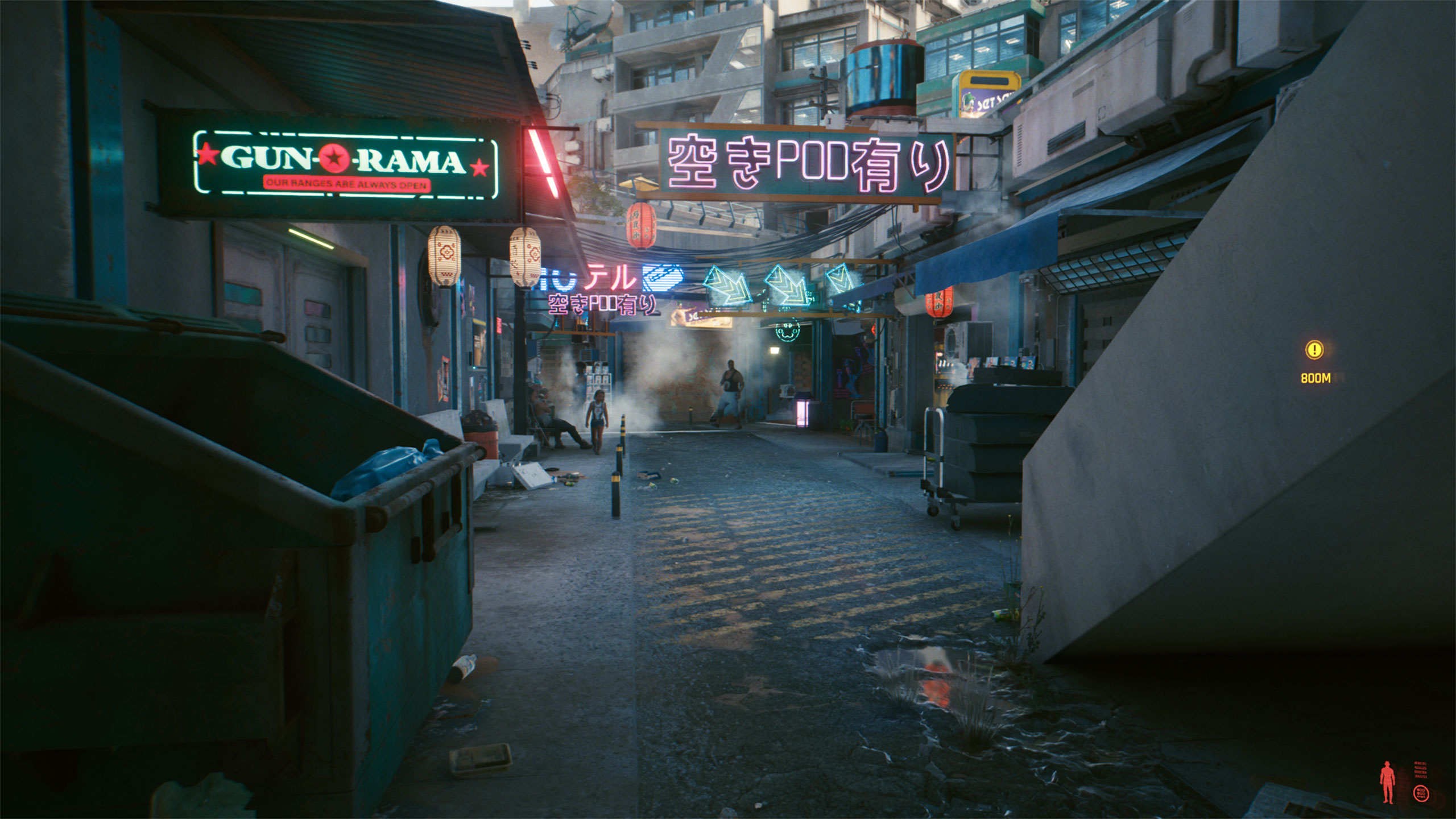
1440p RT Ultra, DLSS Performance

1440p RT Ultra, DLSS Ultra Performance
Let's dig a bit deeper into the DLSS stuff for a moment. Here we've tested one GPU, the RTX 2070 (because you asked for that one) at 2560x1440 RT Ultra and the five different DLSS options, not counting Auto. (Margin of error between benchmark runs is why the result here is a tad slower than the above 1440p Balanced chart, if you're wondering.) Flip through the above gallery for the various image comparison shots.
Based on our testing, which should apply to the other RTX GPUs in situations where they're not CPU limited, Quality mode nearly doubles performance at 1440p. Obviously, the 2070 is struggling quite a bit at 1440p native, but that's a huge jump. Balanced mode is 125 percent faster than Native, Performance mode is 175 percent faster, and Ultra Performance mode is 290 percent faster. Yeah, it can look pretty awful, and it's rendering 1/9 as many pixels before the AI upscaling works its 'magic,' but it's still an option if you need it.
Looking at the image quality, DLSS Quality and Balanced look pretty close. Some areas of the scene actually look better than Native, others look a bit blurrier. There are other parts of the game where DLSS can look better, and worse, but in general we don't have too many complaints about the Quality mode, and even Balanced (at 1440p and above) is pretty good. DLSS Performance mode still looks okay, and at 4K it's viable, but the loss in fidelity is definitely noticeable. Basically, there's a minimum amount of data DLSS seems to require to get a good upscaling result. Obviously, at 1440p, Ultra Performance mode (853x480 upscaled) falls well below that threshold.
As we mentioned elsewhere, you don't have to have ray tracing enabled to use DLSS. Here we've used the same DLSS settings as above, but this time we're only looking at the RTX 2060 using the Ultra preset. 1080p Ultra with DLSS Quality mode enabled gets the card well above 60 fps, and 1440p Ultra with DLSS Balanced mode nearly gets there. We've tested the game on a G-Sync monitor using these settings, and it feels very smooth for the most part — as smooth as Cyberpunk 2077 ever feels right now. 4K Ultra with DLSS Performance mode is also technically playable, staying above 30 fps in our test sequence.
Cyberpunk 2077 Widescreen vs. Ultrawide
If you're a fan of ultrawide monitors, you'll be glad to know that Cyberpunk 2077 supports 21:9 resolutions without any special effort. Above, we ran the RTX 2060 Super (on a slightly different test PC that has a Core i7-9700K CPU and 16GB RAM) at 1080p and 1440p in both widescreen and ultrawide resolutions: 1920x1080, 2560x1080, 2560x1440, and 3440x1440.
The 2560x1080 has 33 percent more pixels than 1920x1080, while 3440x1440 has 34 percent more pixels than 2560x1440. At the Ultra preset performance drops by 17 percent for both resolutions. The RT Ultra preset tends to be almost completely GPU limited, and performance drops by 19 percent at 1080p and 24 percent at 1440p. A faster GPU (eg, RTX 3080) would likely see less of a performance hit as it's more likely to be at least somewhat CPU limited, particularly at 1080p.
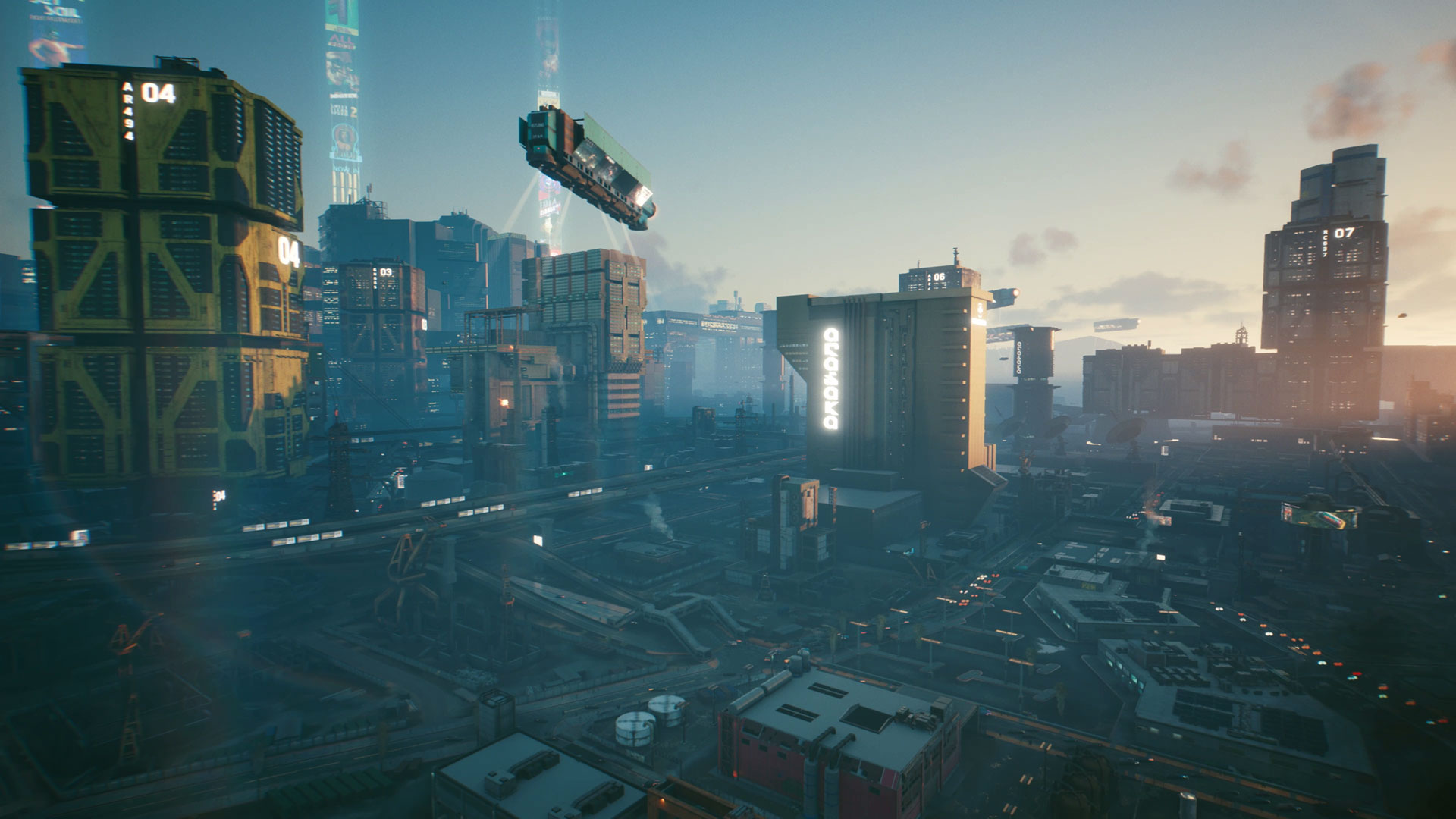
Cyberpunk 2077 Likes Newer GPUs
One of the key takeaways is that Cyberpunk 2077 really prefers later generation hardware, particularly if you're hoping for 60 fps or more. AMD's GPUs also win many of the head to head matchups against their closest Nvidia competitors, with ray tracing and DLSS disabled.
Still, Nvidia's RTX GPUs do quite well at running the game, with or without ray tracing. If you're willing to step down from maximum settings, any RTX card will at least average 60 fps. The newer RTX 30-series GPUs tend to have sufficient power under the hood for RT Ultra settings, and provide the best visual experience, but cards like the 2060 Super still do fine, and AMD's RX 5600 XT and above won't have any trouble delivering a good gaming experience.
Older generation architectures are another matter, especially on the Nvidia side of the fence. GTX 16-series Turing architecture GPUs do far better compared to GTX 10-series alternatives than we normally see. Is that a lack of optimization for Nvidia's Pascal architecture, or is it a case of Cyberpunk 2077 using DirectX 12 (DX12) in ways that simply benefit the newer architectures more? That's a bit tough to determine, but AMD's older GCN architecture chips tend to fare much better overall. (For what it's worth, Maxwell GPUs seem to perform relatively similar to their Pascal counterparts.)
Back in 2017, the RX Vega 64 was pretty disappointing. It was generally slower than the GTX 1080, never mind the newer and even faster GTX 1080 Ti. Three years later, running Cyberpunk 2077? Vega 64 is a solid 15-20 percent faster. On the other hand, the GTX 1660 Super, which normally matches the older GTX 1070, ends up matching and even beating the GTX 1080 in some cases.
Cyberpunk 2077 Performance: Image Quality Comparisons
Given what we've seen in terms of performance, you're probably wondering how the game actually looks at the various settings. We have some screenshots, and we'll be digging into these more in the coming days. If you're wondering whether ray tracing makes the game look better, we'd say the answer is an unequivocal yes. Is it worth the performance hit, though? That's a bit more difficult. Here's a gallery of screenshots taken with various settings.
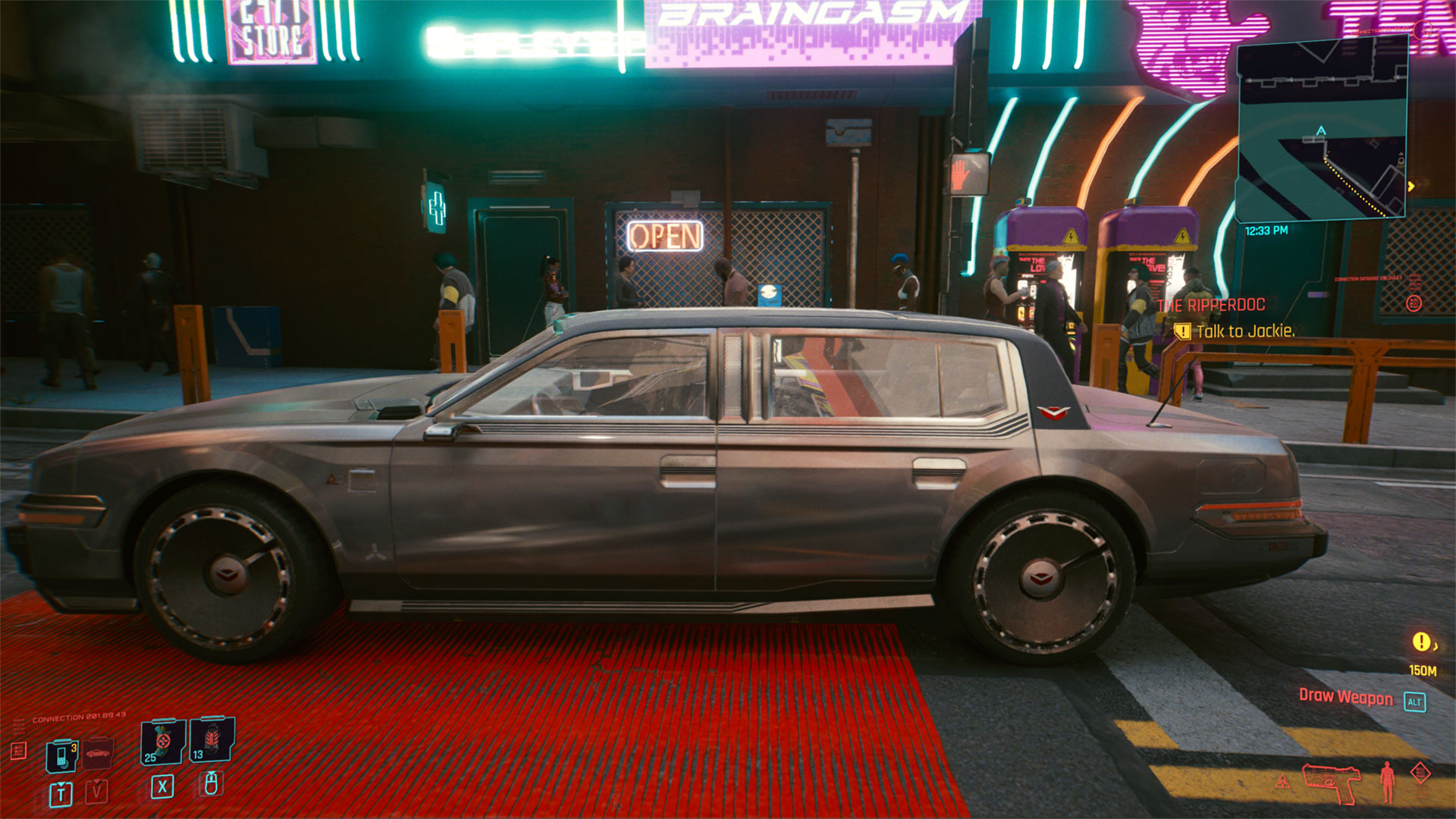
RT Ultra Preset
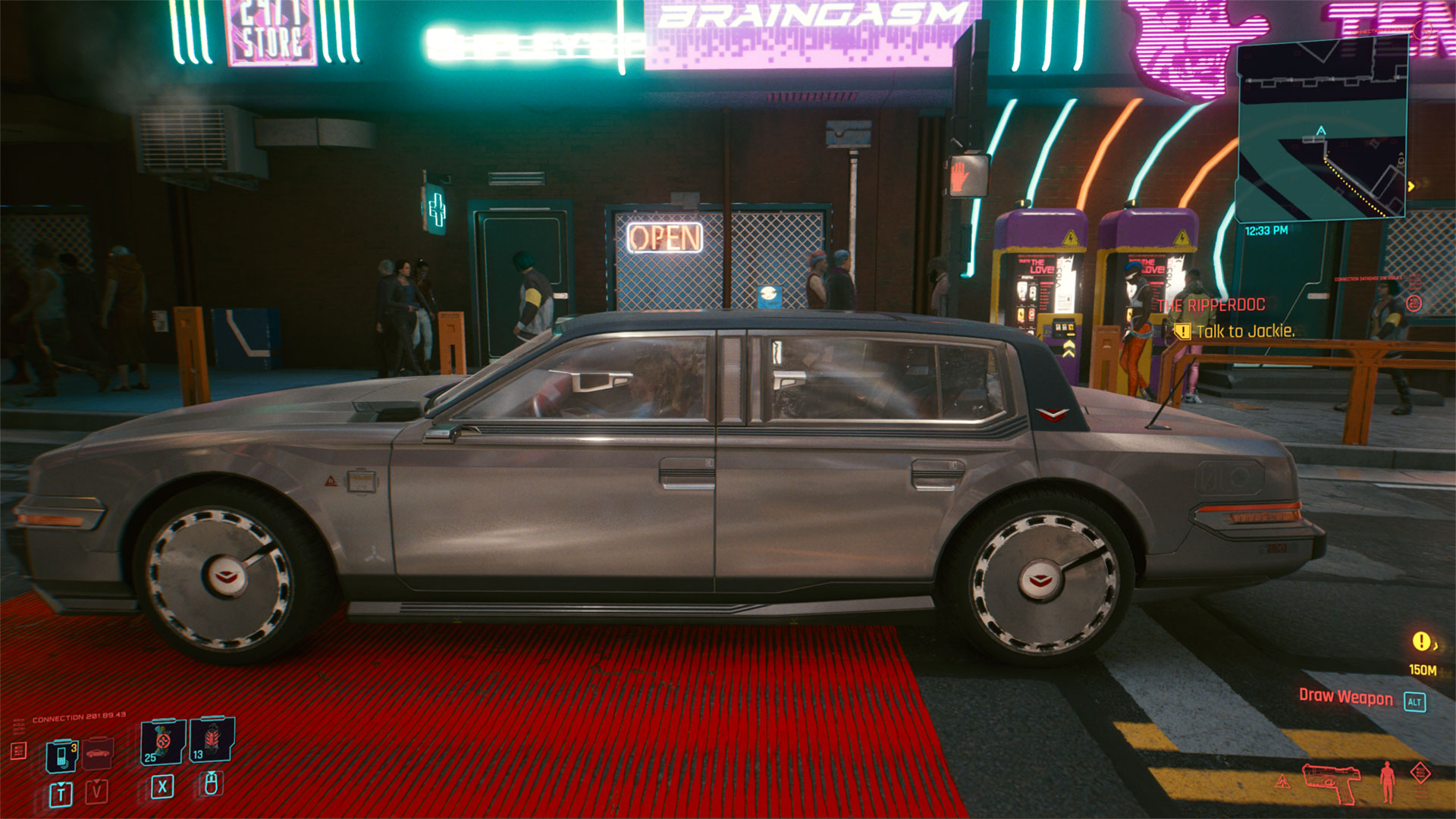
RT Medium Preset

Ultra Preset
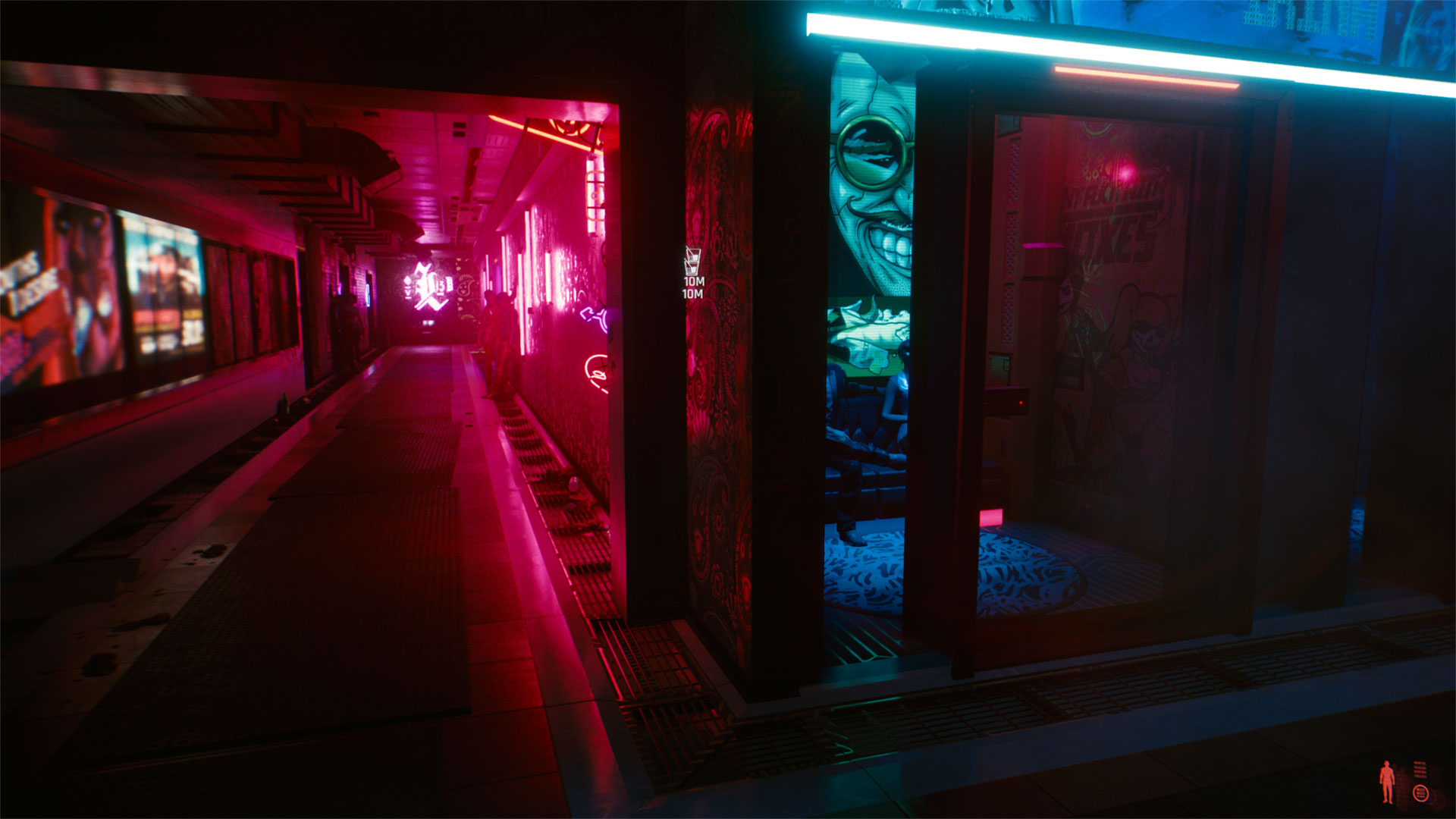
Ultra Preset (no RT/DLSS)

RT Ultra (no DLSS)

RT Ultra with DLSS Quality

RT Ultra with DLSS Balanced
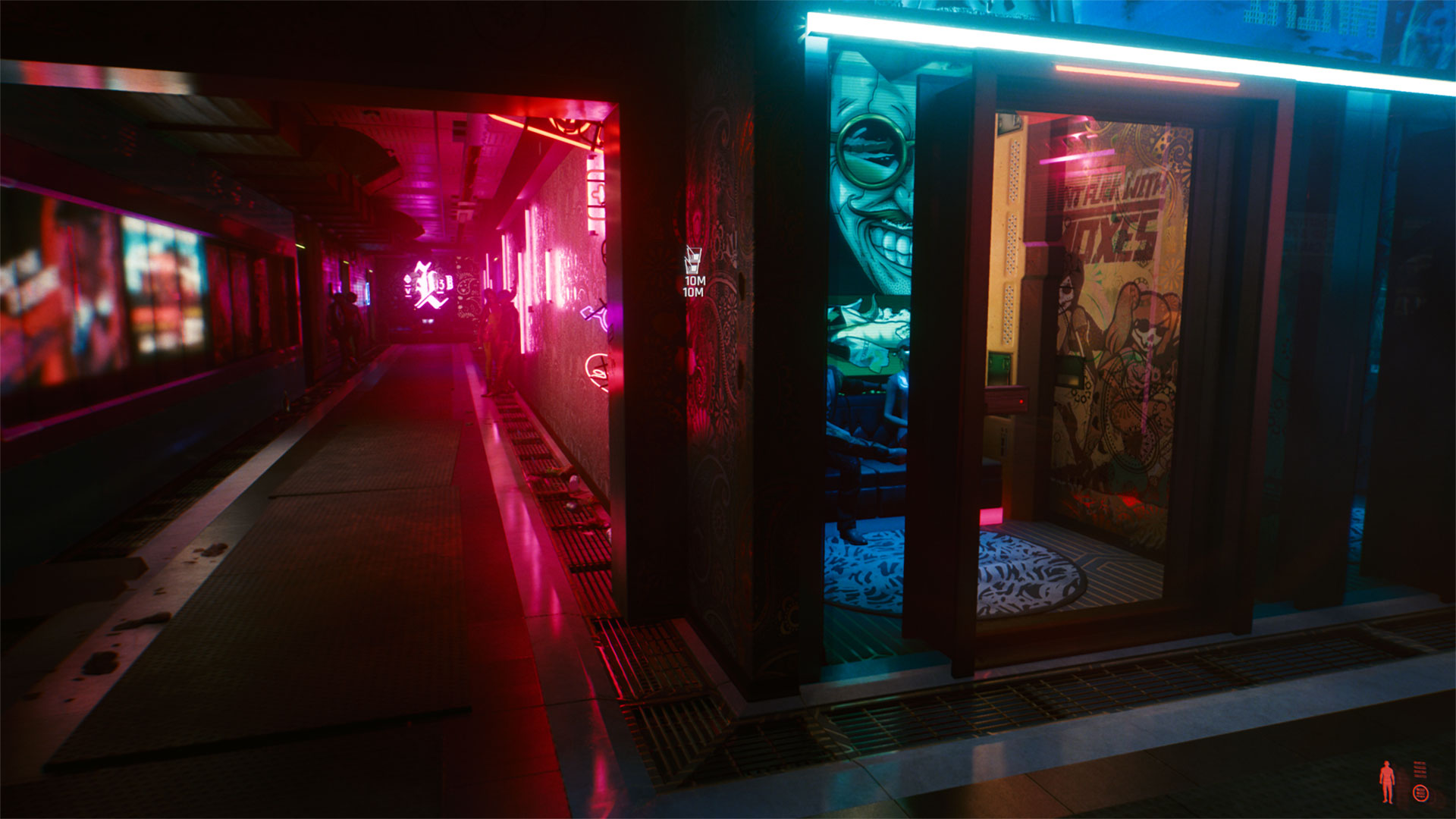
RT Ultra with DLSS Performance

RT Ultra with DLSS Ultra Performance
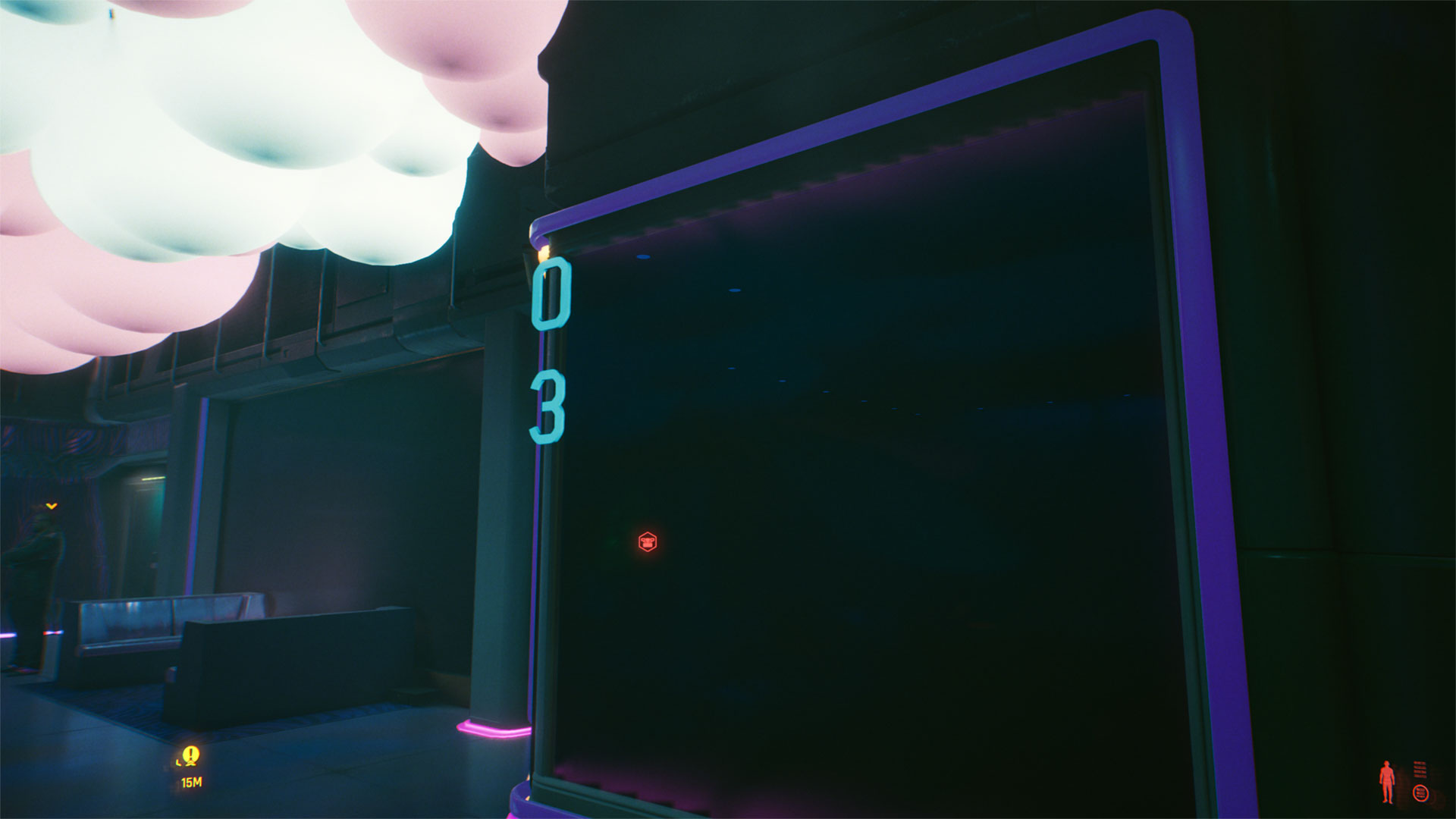
Ultra Preset (no RT or DLSS)
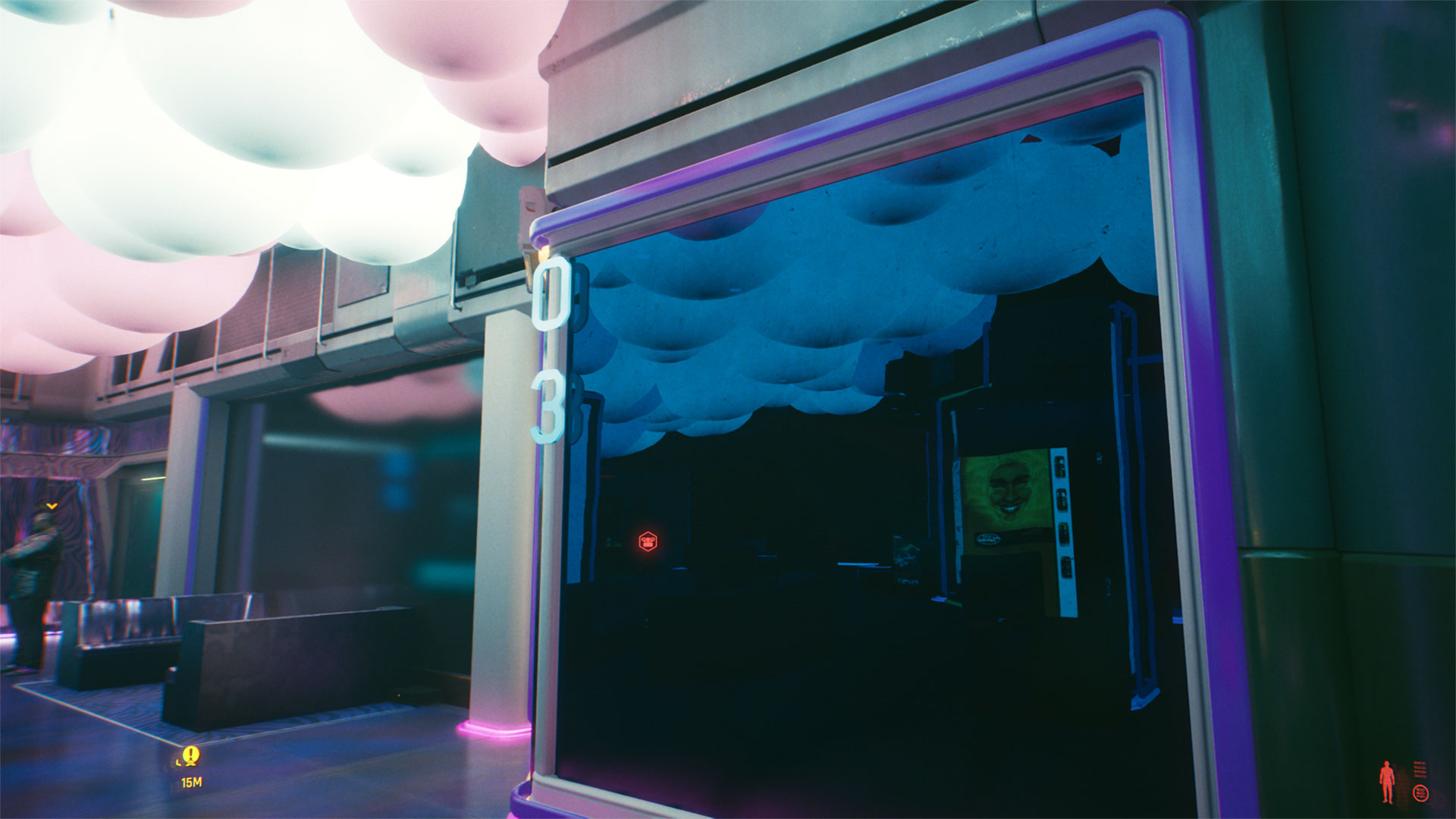
RT Ultra Preset
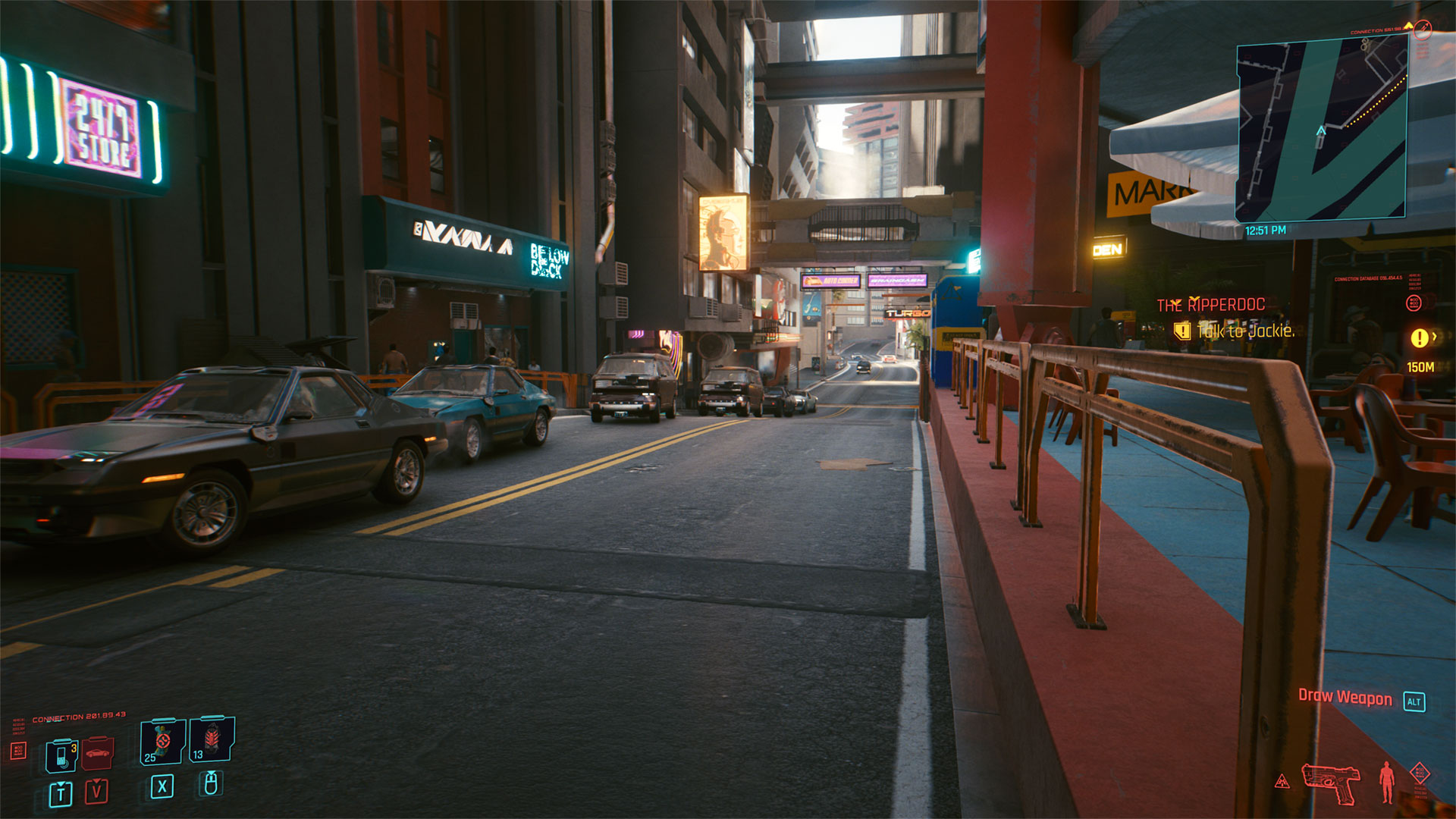
RT Ultra with DLSS Ultra Performance

RT Ultra with DLSS Performance

RT Ultra with DLSS Balanced
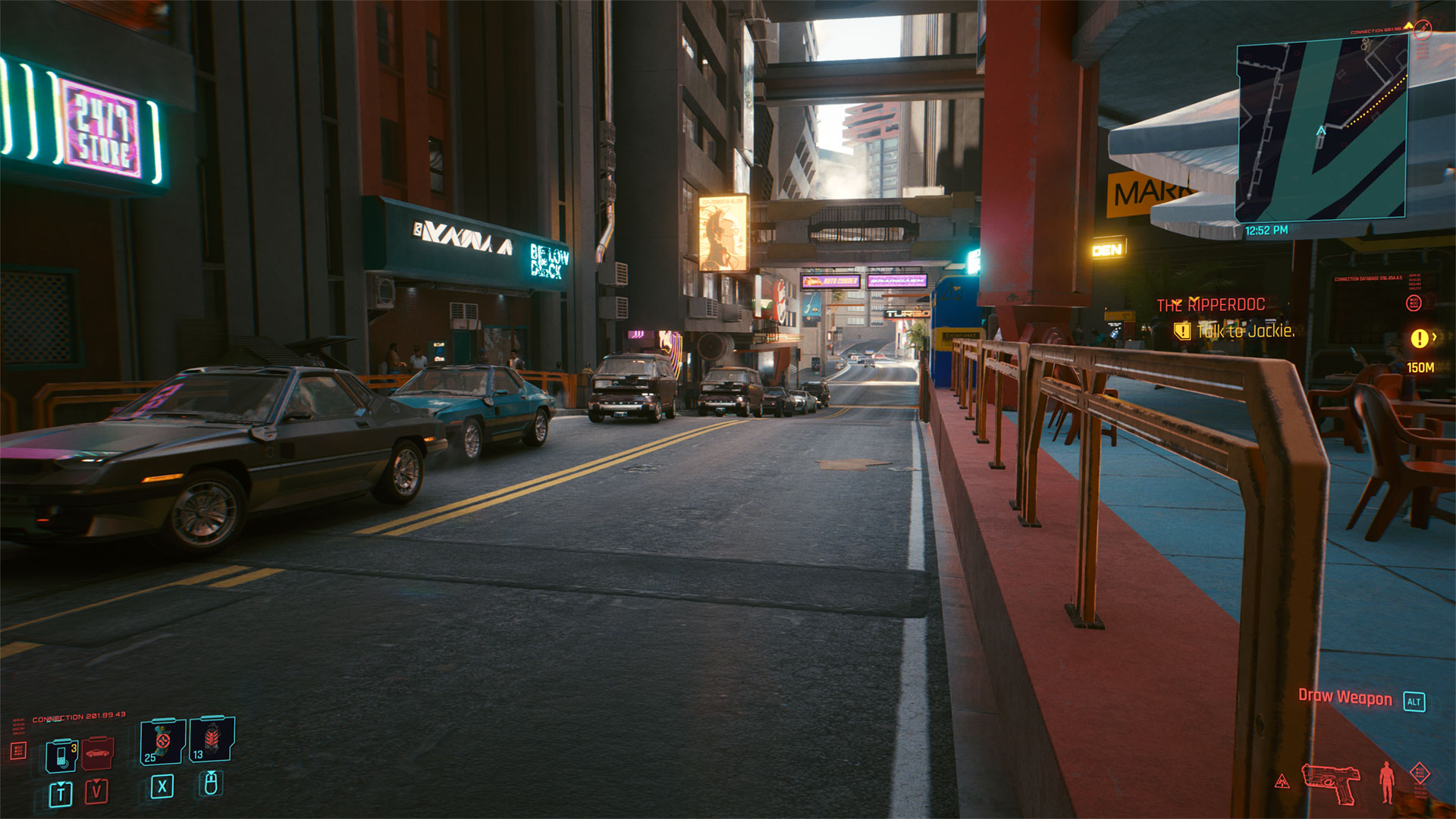
RT Ultra with DLSS Quality
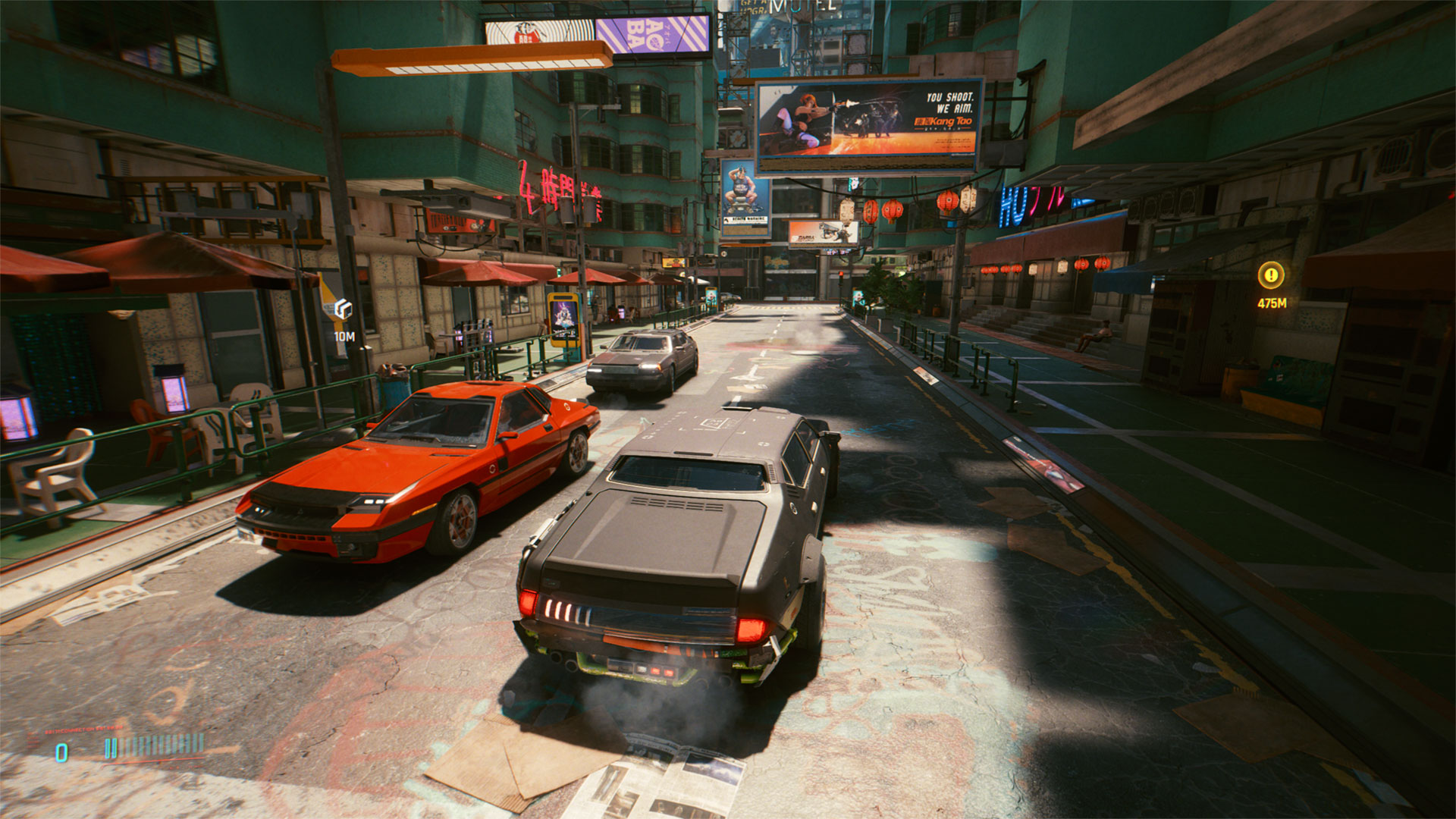
RT Ultra (no DLSS)
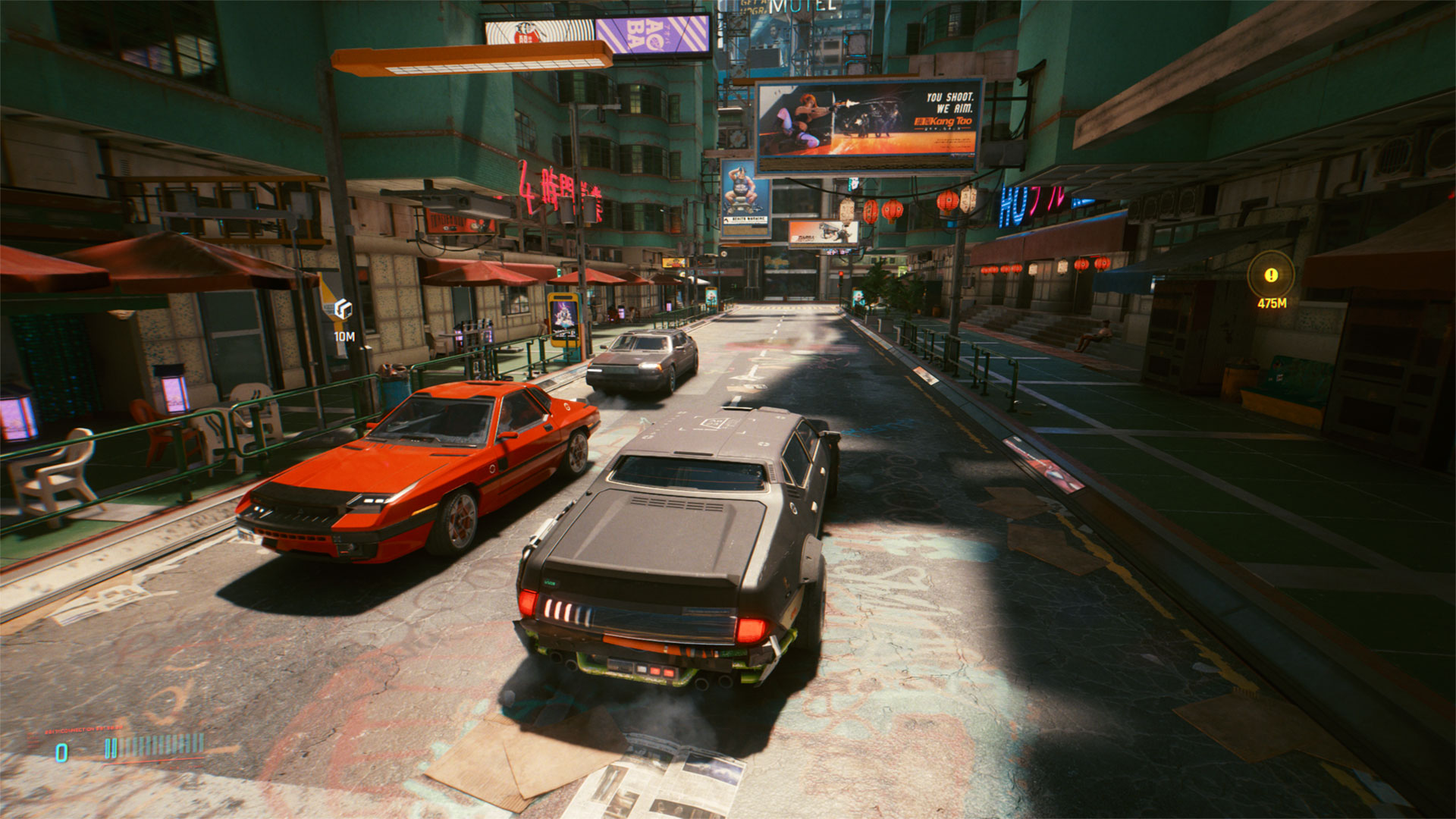
RT Ultra with DLSS Quality
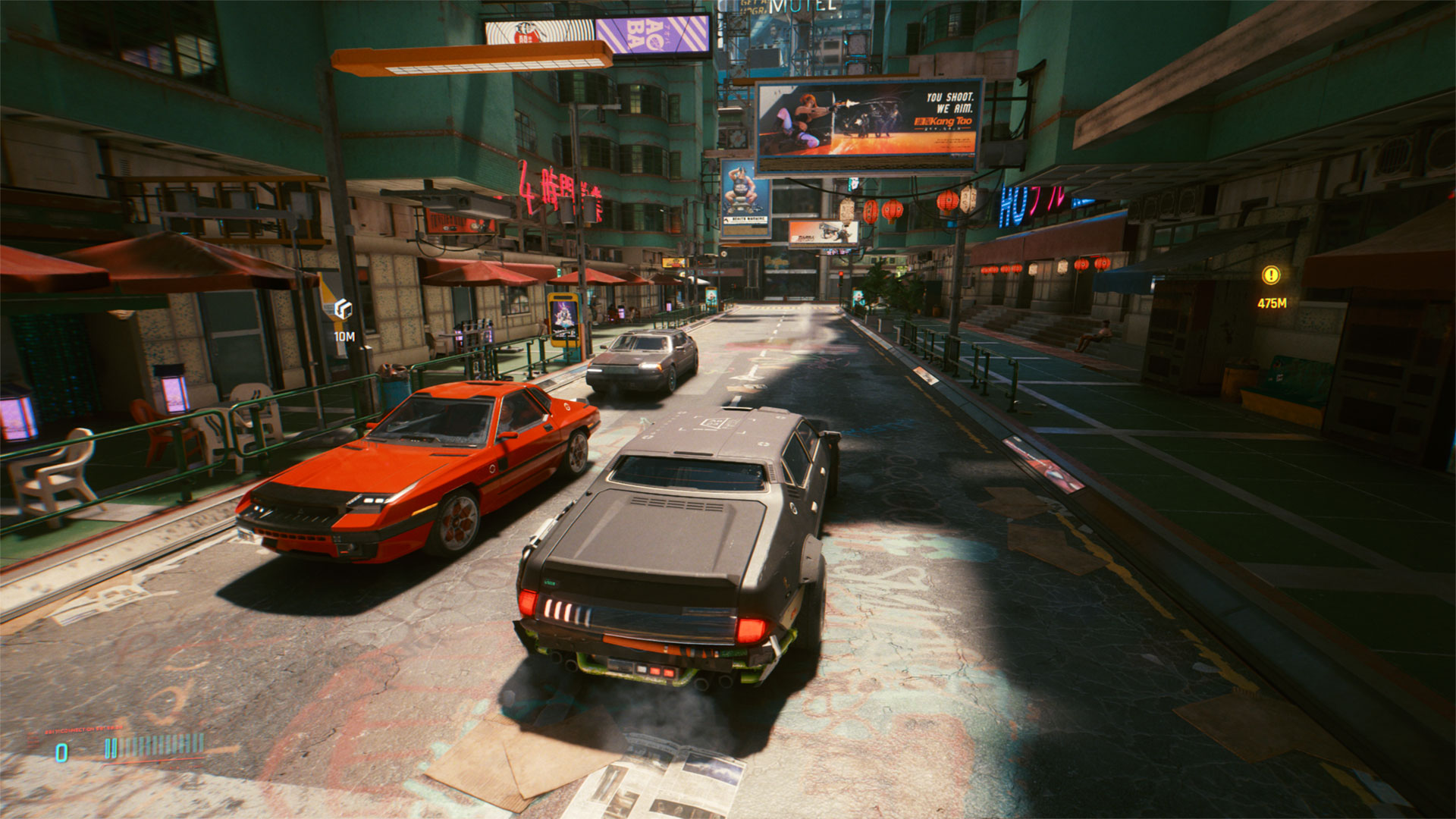
RT Ultra with DLSS Balanced
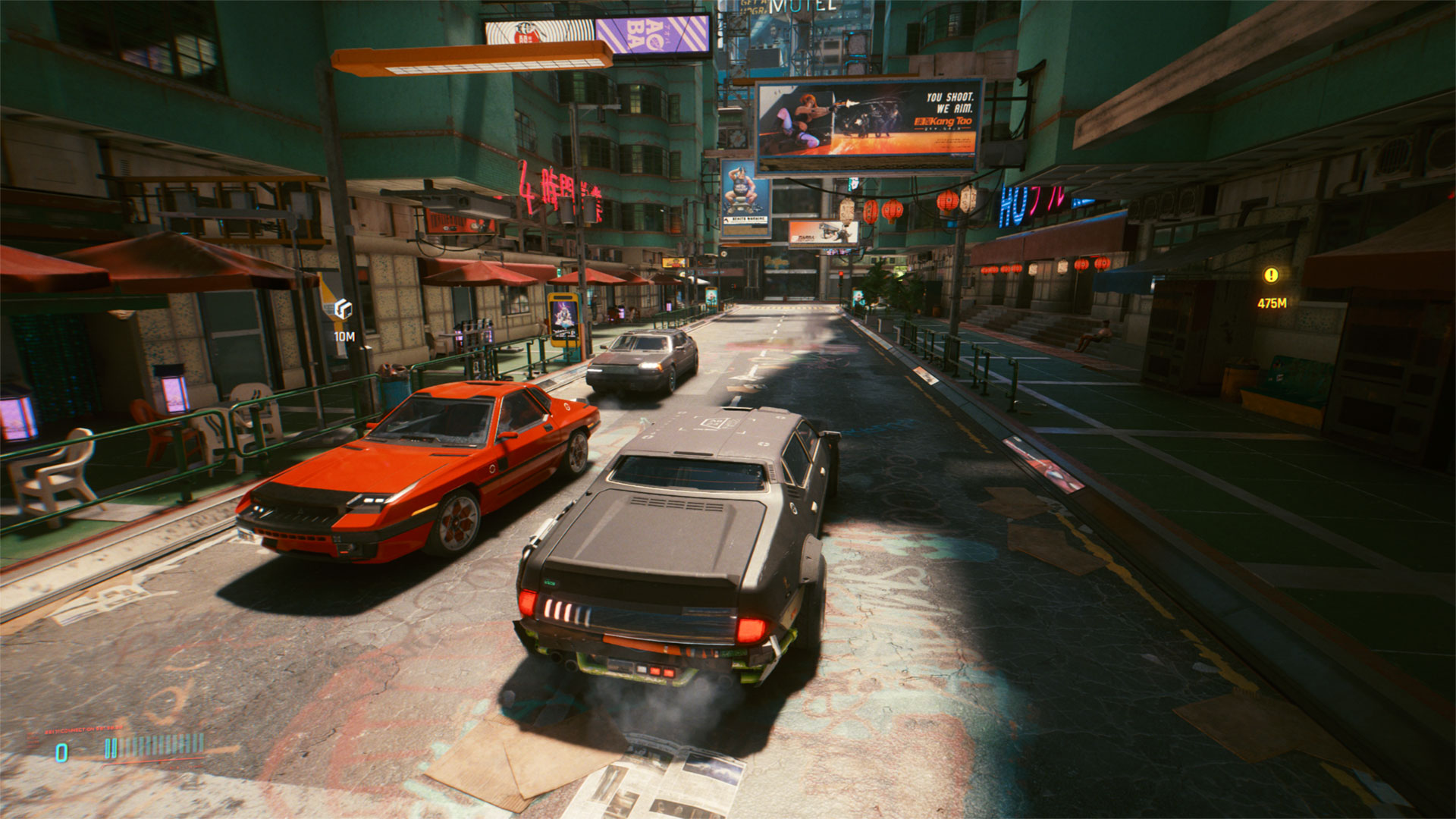
RT Ultra with DLSS Performance

RT Ultra with DLSS Ultra Performance
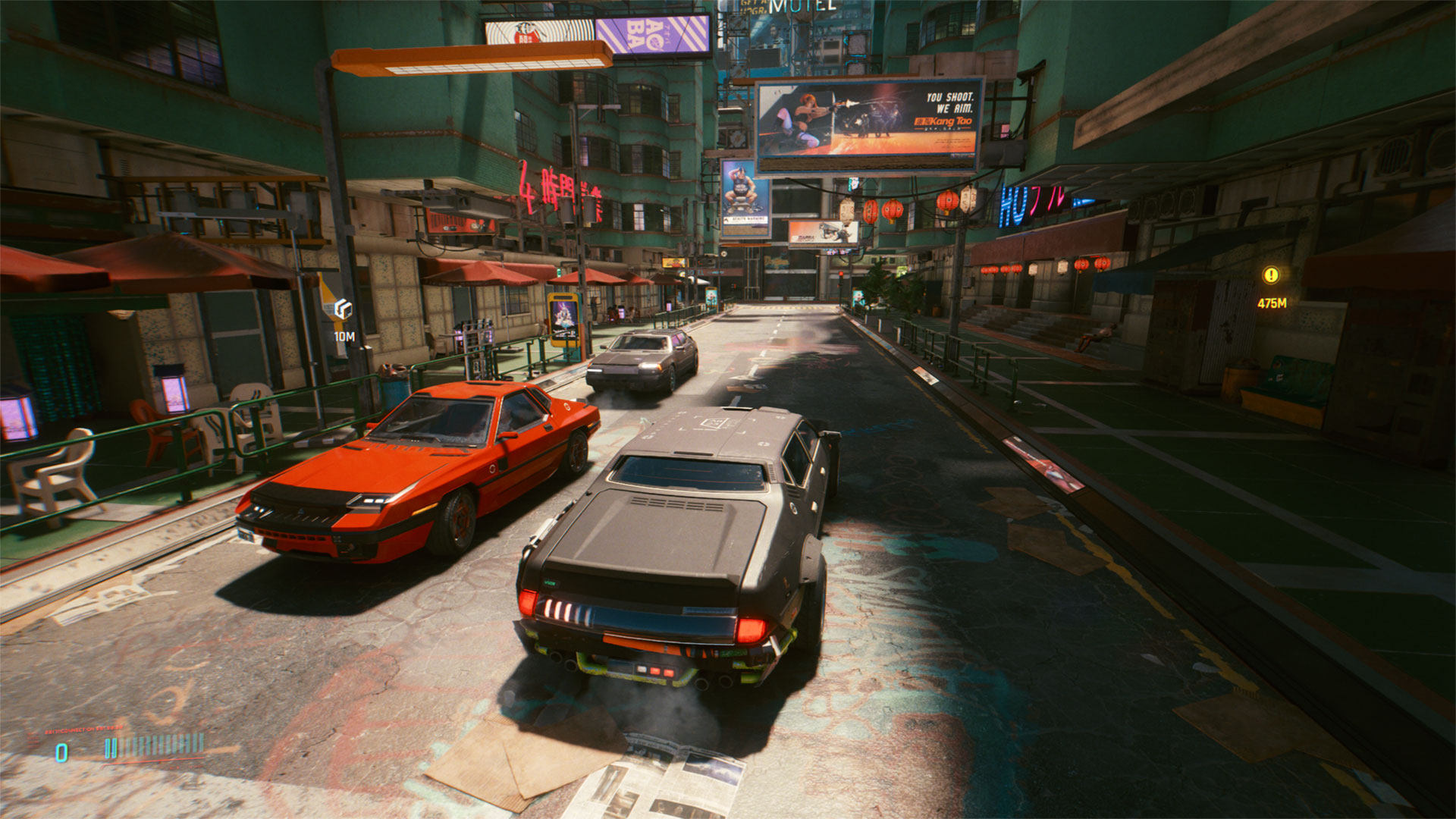
RT Medium with DLSS Quality

Ultra Preset (no RT or DLSS)
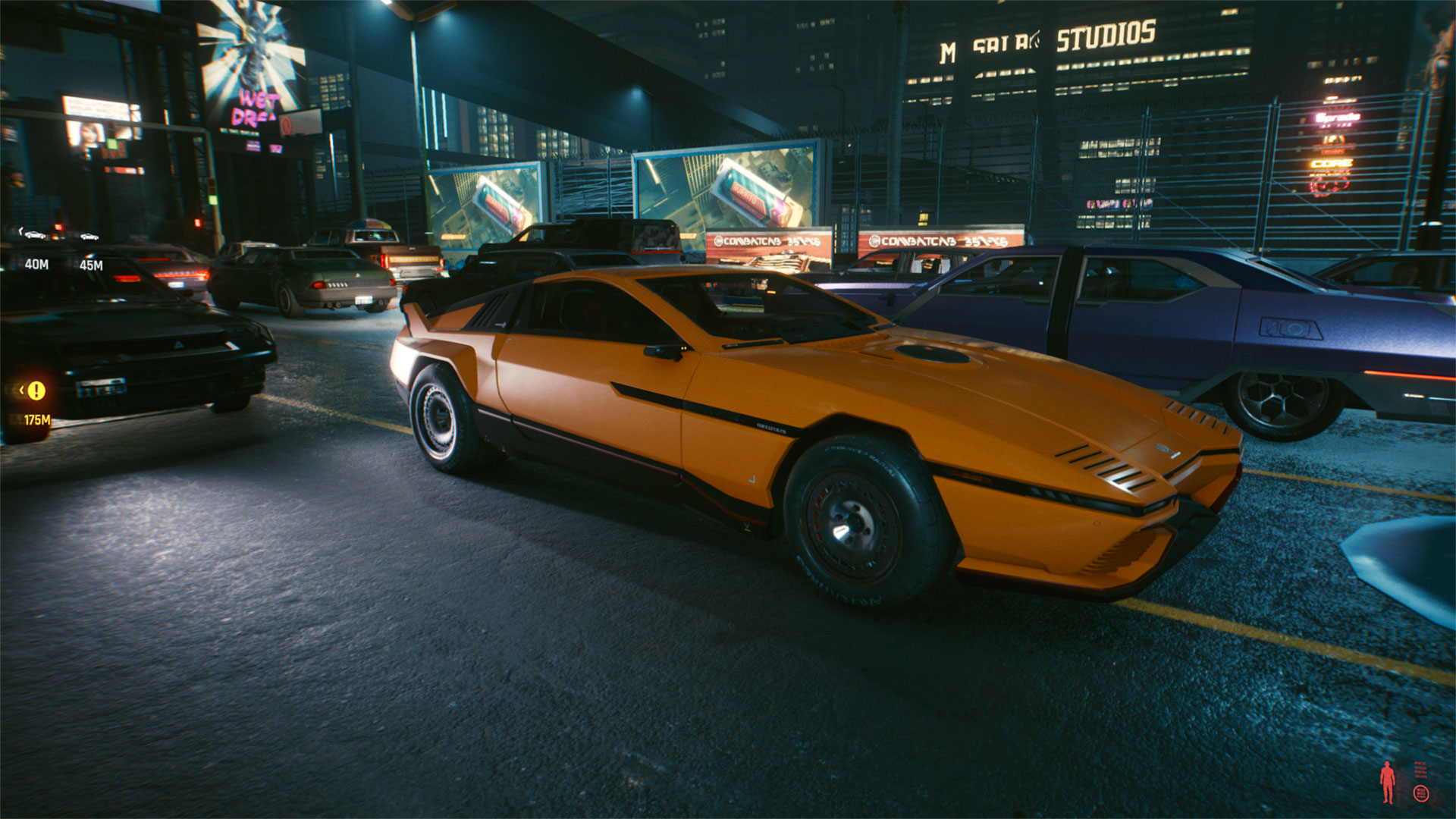
Ultra Preset (no RT or DLSS)
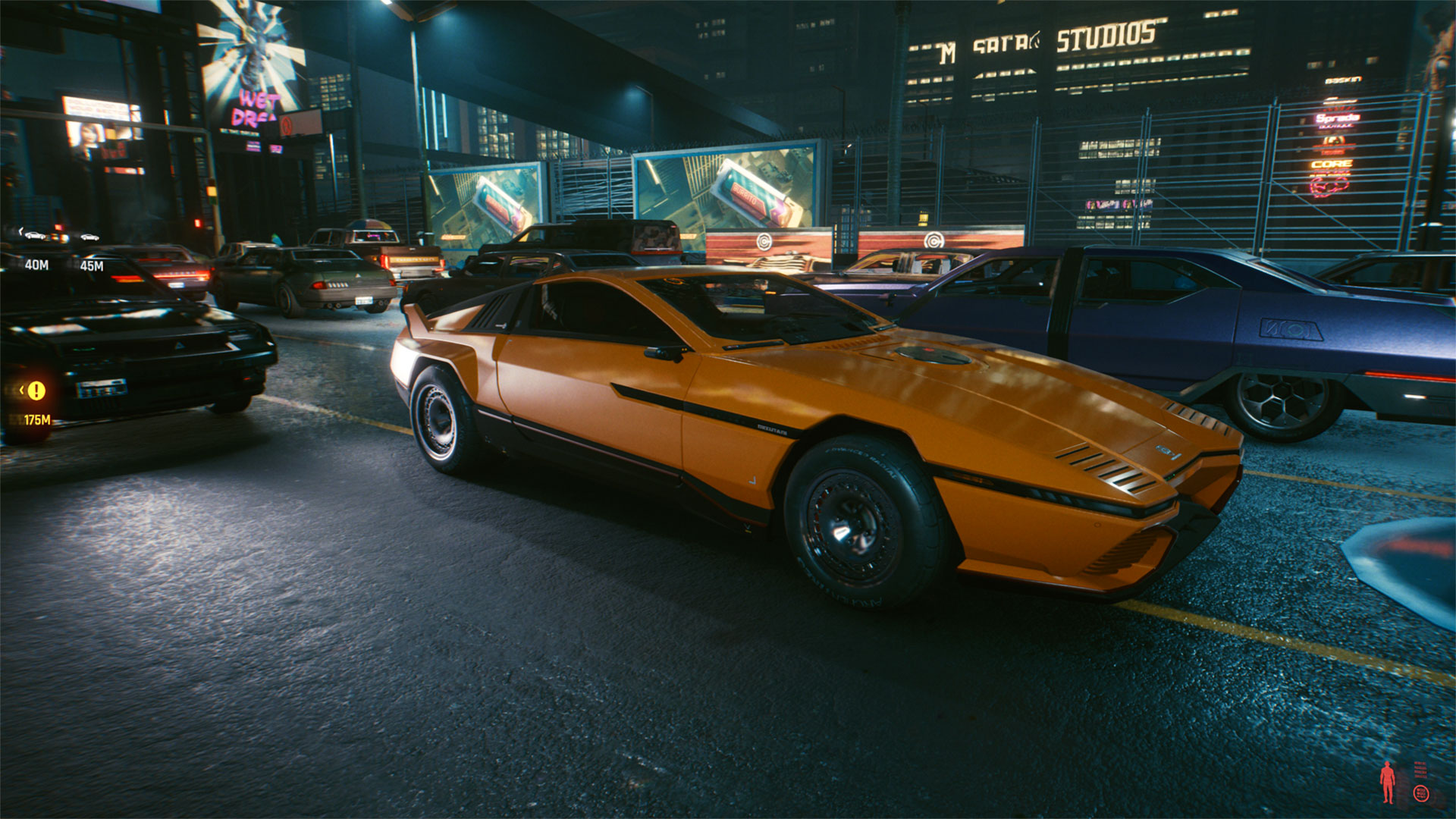
RT Ultra Preset (no DLSS)

RT Ultra with DLSS Ultra Performance

RT Ultra with DLSS Quality
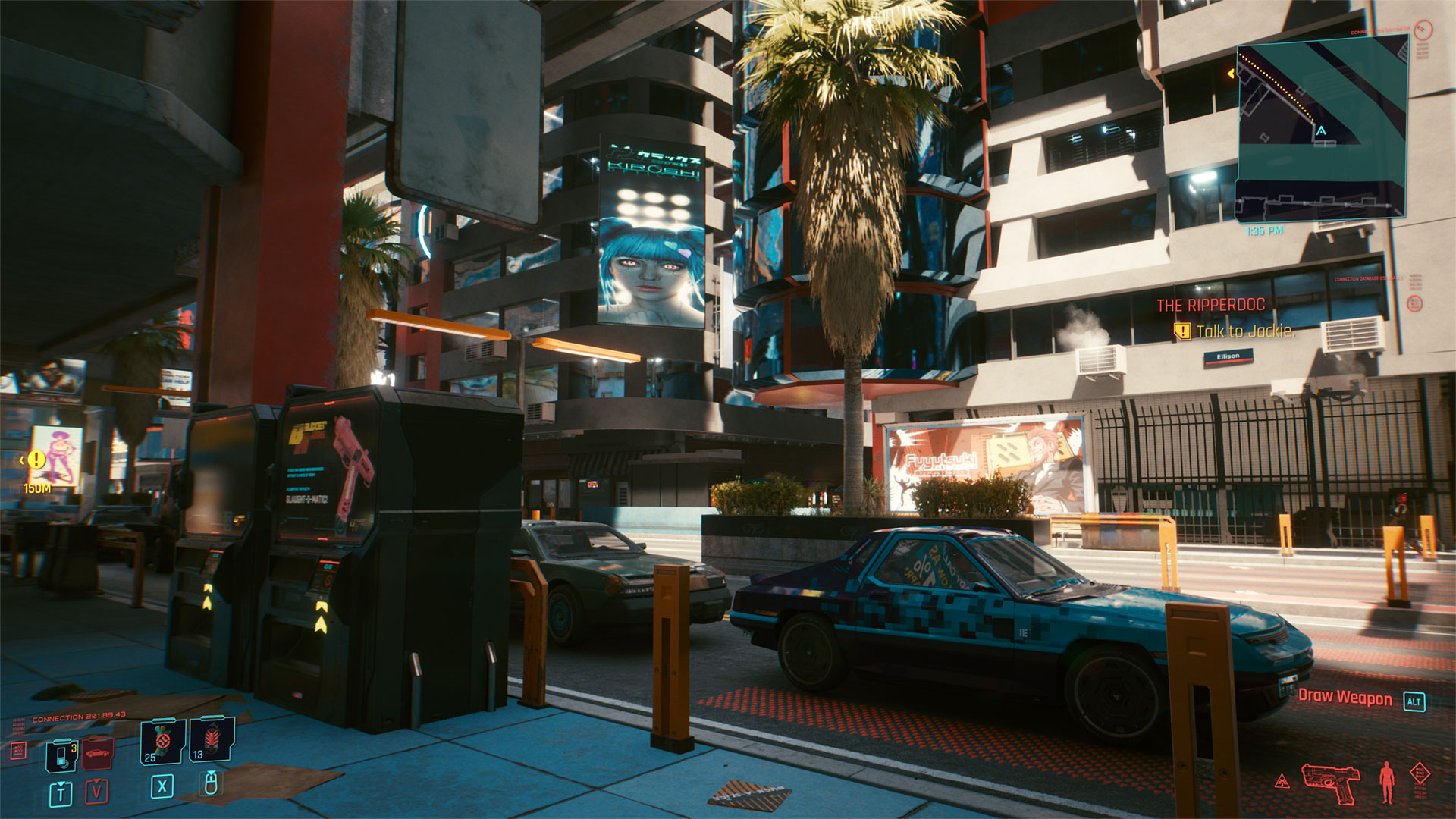
RT Ultra (no DLSS)
There's a lot to sort through, but reflections can be very noticeable in some scenes and not matter at all in others. Stand next to a car, and the presence or lack of reflections on the windows is definitely apparent—and I miss them when they're gone! Walk a few meters away from the car, however, and it's not nearly as noticeable. On the other hand, some rooms and buildings have reflective walls, and after walking around a club called Clouds with RT enabled, turning RT off made the place feel completely different. All the mirrored surfaces turn into dark walls instead.
There are other oddities with reflections, however, like the fact that V doesn't cast a reflection. We found this to be very weird, particularly for a game that allows you to play dress-up with all sorts of articles of clothing. Want to see how V looks? Either go into your inventory, or enter photo mode, or go to a bathroom mirror and press F. Yeah, we're not sure why or how the mirror turns off, but it does.
Perhaps V actually stands for Vampire, and that's why the player character doesn't cast a reflection? Running around Control and seeing Jesse in the reflective surfaces was great, and we've seen the same thing in Battlefield V, Wolfenstein Youngblood, and Watch Dogs Legion. But even in third-person perspective sitting on a motorcycle, V is missing from reflections. This omission feels like something that needs to be patched because currently the RT reflections just feel wrong with the lack of V.
What about the RT shadows and lighting? Here, the differences between rasterization and ray tracing aren't nearly as apparent. Yes, the shadows look better with RT, and you get the blended penumbra at the edges compared to a hard edge with shadow mapping. But even the RT shadows and lighting don't get everything right—vehicle headlight projections sometimes show up where they shouldn't be visible.
Basically, ray tracing in Cyberpunk 2077 feels like something that's all or nothing. If you have a sufficiently fast graphics card—RTX 30-series, or maybe 2080 Super and 2080 Ti—you can run with the RT Ultra preset and DLSS and get a pleasing result. RT Medium is okay as well, but not as visually striking. But if you don't have a high-end RTX card that can do DLSS, (ie, AMD's RX 6000 GPUs), FidelityFX may be a good enough alternative to hit 60 fps. You can also try FidelityFX CAS on the Nvidia RTX cards if you want.
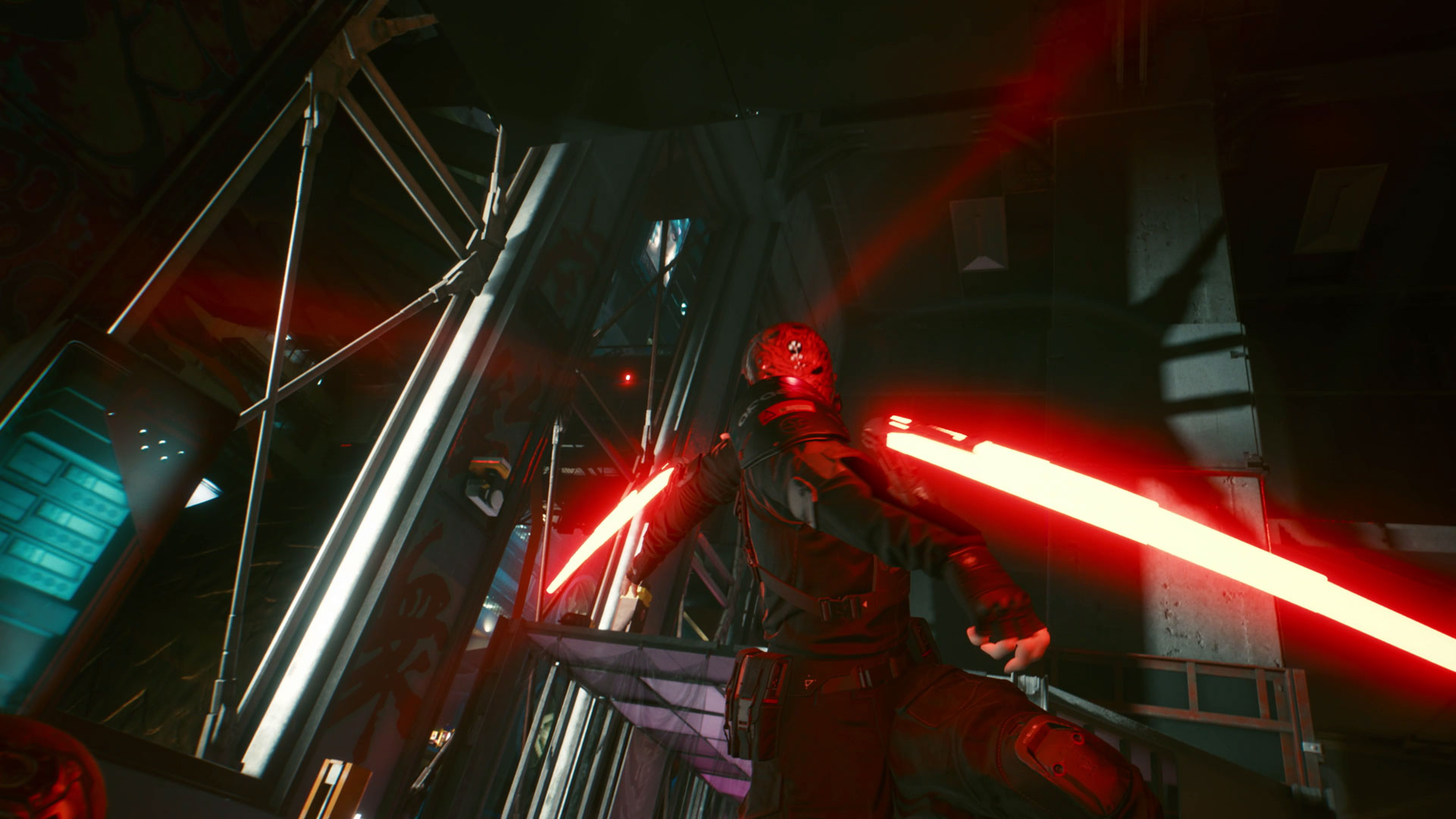
Cyberpunk 2077 Launch Performance Impressions
What about the game, though? Is Cyberpunk 2077 actually good? We're not normally game critics, but most gaming sites like it quite a lot. Scores range from around 80 up to fanboytastic 100, with most complaints centering on the janky aspects of the game and the sometimes weak story telling.
This sort of game tickles all the rights spots in my brain. There are always lots of jobs and side missions vying for attention, and plenty of other activities as well. Running around this futuristic dystopian city feels great. At the same time, the game can quickly venture into the realm of too much stuff going on.
It's like many other open world games in that respect. Open the map and there are dozens of points of interest to visit, many just repeats of stuff you've already done a dozen times. Some side missions have you running around the various Night City zones looking for specific items, vehicles, or even graffiti. And every new part of town, you'll immediately get a call the first time you enter from the local fixer. "Hey, V, come on by because I've got a job for you!" Yeah, you and everyone else. Well, not everyone.
Most of the people of Night City are procedurally generated. Superficially, it looks and feels reasonable. People walk along sidewalks, stop at crosswalks, avoid cars, grumble when you bump into them, have conversations, and more. But the vast majority are just cardboard props. You can scan them for a name and details, but they're not persistent—scan someone, save your game, and then load the save, and you'll likely find the person you just scanned has disappeared.
Focus too much on any one denizen walking the streets and you can also run into problems. Sometimes they behave erratically, sometimes they teleport around a bit, and sometimes they just disappear (or pop into existence). The same can happen with automobiles, though it doesn't seem to occur as often.
Also, hopefully you like clones. There's enough randomization that you don't immediately notice the repeated people, but after a few hours you'll start to see the same models pop up again and again. Sometimes you'll run into a crowd where you'll see the same model repeated three or more times, hanging out and having a little party. Or maybe they're triplets or quadruplets that all wore the same outfit that day? Anyway, it's not bad as such, but most of the people aren't unique individuals with a schedule that they follow. Night City isn't like The Elder Scrolls in that sense.
But the story is good so far, and I'm looking forward to seeing how it all comes together. Compared to The Witcher 3, the story and writing don't feel as strong, and the bones of The Witcher 3's engine are readily apparent. (It had plenty of clones and cardboard cutout personalities as well.) Maybe things will pick up down the line, maybe I'll come to appreciate V as a character more. Maybe Johnny won't be such a jerk. It's also nice to have V be my version of the character, whether that's a Streetkid brawler or a Corp technical. Except, in letting players craft their own V, he/she/it/they becomes less of a focus point for the story.
There are still plenty of glitches and technical problems, unfortunately—bugs like objects floating in the air instead of dropping to the ground, people and vehicles popping into existence at the wrong time, missions failing to progress and requiring a reload. In one scene, manning a minigun in a helicopter, I had to clear out all the enemies before we could land. Except, I did that and we just kept circling for several minutes before I had to reload and try again. I don't know how many of these issues have been fixed in the release version, but teleporting entities and repetitive clones are very much still a thing.
At least full-blown crashes were rare, and the few times they happened tended to be after I changed settings (for the fifth or sixth time). That's with a very much high-end PC, however, running a relatively clean Windows 10 installation. If you have an older rig with tons of other junk running in the background, your experience might be worse.
Performance so far is generally acceptable and mainstream or higher hardware, provided you're willing to run at less than maxed-out settings. Midrange hardware from several years back may struggle at times, but a modern $230 GPU like the GTX 1660 Super or $270 RX 5600 XT should be more than sufficient. We'd also recommend at least a 6-core/12-thread CPU, SSD storage, and 16GB of RAM (possibly 32GB), particularly if you have a reasonably high-end GPU. Based on what we saw during testing, older generation 4-core CPUs are going to have a difficult time hitting 60 fps at higher quality settings, pretty much regardless of how fast your GPU is.
If you're itching to jump into Night City and Cyberpunk 2077, I personally have found plenty to enjoy and don't have any major reservations in recommending it. You could hold off a few more weeks, or maybe even months, depending on how upset you get about glitches. I can live with them, but others may find them off-putting. At some point, a Deluxe / Game of the Year edition seems inevitable, so you could wait for that.
Also, this is very much an M-rated game, so if language, violence, or sex in games offend you, you're best steering clear. (There's a nudity filter, but no profanity filter, and violence is everywhere. This is very much the equivalent of an R-rated film, if that matters to you.)
For everyone else, there's plenty to do, and I can see myself spending many more hours here—and not just running benchmarks! Which we still have plenty left to do, now that the release version of the game is here. We've got plans to do CPU and RAM testing before we wrap this benchmark bonanza up with a tidy bow and move on the other things. Probably just in time for some major patches to arrive and hopefully address some of the performance concerns.

Jarred Walton is a senior editor at Tom's Hardware focusing on everything GPU. He has been working as a tech journalist since 2004, writing for AnandTech, Maximum PC, and PC Gamer. From the first S3 Virge '3D decelerators' to today's GPUs, Jarred keeps up with all the latest graphics trends and is the one to ask about game performance.
-
saunupe1911 5900x and EVGA FTW3 3080 Ultra in my rig. Getting over 70 FPS at 1440p Ultra with Full Ray Tracing and DLSS set to Auto. I think Auto finds a real nice balance between fast and slow paced moments. The game looks great!Reply -
MorganPike The bugs are real. Like Bethesda level. Nothing game breaking so far but it's just my first couple hours. I'll give them some time to smooth it out. Runs great in 1440 on my 2070 though.Reply -
randomizer Will you be putting up charts for DLSS without RT (it does sound like you tried it with the 2070 Super)? This seems like the only way many of the lower end cards will manage good framerates above 1920x1080 without significantly lowering the graphics.Reply -
JarredWaltonGPU Reply
I haven't been doing those tests on the initial pass, but I can look into it if there's enough interest. The general rule is that DLSS Quality adds ~50% if you're GPU limited, DLSS Balanced adds ~80%, and DLSS Performance can more than double performance. I find the upscaling artifacts of DLSS Performance quite noticeable at 1080p and even 1440p, though, which is why I've tested at 1080p Quality, 1440p Balanced, and 4K Performance.randomizer said:Will you be putting up charts for DLSS without RT (it does sound like you tried it with the 2070 Super)? This seems like the only way many of the lower end cards will manage good framerates above 1920x1080 without significantly lowering the graphics. -
dyoustra ReplyJarredWaltonGPU said:I haven't been doing those tests on the initial pass, but I can look into it if there's enough interest. The general rule is that DLSS Quality adds ~50% if you're GPU limited, DLSS Balanced adds ~80%, and DLSS Performance can more than double performance. I find the upscaling artifacts of DLSS Performance quite noticeable at 1080p and even 1440p, though, which is why I've tested at 1080p Quality, 1440p Balanced, and 4K Performance.
I second his request :). Also, when you do test DLSS w/o RT, can you use a mix of lower/higher cards? Throw in a 1080Ti if possible. -
dyoustra Can you test the DLSS auto setting as well? Does it generally lean towards better graphics or performance? Would you recommend it over manually selecting the DLSS setting that best fits your resolution/performance needs (E.g balanced on 1440p)?Reply -
ssj3rd So the most interesting setting for me isn’t here yet, sigh:Reply
1440p - RT Ultra - DLSS Quality -
rfour_ Why is the GTX 1070 struggling so much compared to the 1660 Super? When in most other titles on average they're pretty close with an edge to the GTX 1070 at 1440p for example (averaging a 4% lead over an average of 11 titles). In Cyberpunk 2077 that flips and translates into a 21% lead for the GTX 1660 at 1440p medium over the GTX 1070. Downloading the game now but a little scared to see how my GTX 1080 performs. 👀It seems the 10 series cards under performing a little, relative to other titles. Even the 1080 Ti goes from normally being 12.5% quicker than a 5700 XT in that same 11 title average to nearly 13% slower. It goes from practically matching the 2070 Super to being nearly 28% slower in Cyberpunk. This is just raw rasterization power that is not being translated and it actually makes no sense. The delta between the 10 series and other newer cards seems relatively larger than the norm and I'm curious as to why? I get it's a 2 generation old card but cards like the GTX 1080TI, GTX 1080, and GTX 1070 still extremely relevant, in wide use in a wide number of hands, and it is generally disappointing to see the poor optimizations for "older" hardware. Especially when they have 10 series cards on their recommended specs list like the GTX 1060 you'd assume optimization for "older" tech would be better. Also curious to see how some other older cards run on the lower settings in further benchmarking.Reply -
RTX 2080 Replydyoustra said:I second his request :). Also, when you do test DLSS w/o RT, can you use a mix of lower/higher cards? Throw in a 1080Ti if possible.
The 1080 Ti doesn't have Tensor cores, so you can't test it for DLSS. -
JarredWaltonGPU Reply
Different GPU architectures. Pascal was released in 2016, and it doesn't have all of the updates present in Turing. Concurrent FP + INT may be part of it, probably Turing is just better with DX12 code as well. It might also just be optimizations targeting Turing and Ampere more than Pascal, but there are other cases where GTX 1660 Super does better relative to GTX 1070. It's not the usual case, but also not impossible, particularly with a game that's using a lot of high-end visual techniques.rfour_ said:Why is the GTX 1070 struggling so much compared to the 1660 Super? When in most other titles on average they're pretty close with an edge to the GTX 1070 at 1440p for example (averaging a 4% lead over an average of 11 titles). In Cyberpunk 2077 that flips and translates into a 21% lead for the GTX 1660 at 1440p medium over the GTX 1070. Downloading the game now but a little scared to see how my GTX 1080 performs. 👀It seems the 10 series cards under performing a little, relative to other titles. Even the 1080 Ti goes from normally being 12.5% quicker than a 5700 XT in that same 11 title average to nearly 13% slower. It goes from practically matching the 2070 Super to being nearly 28% slower in Cyberpunk. This is just raw rasterization power that is not being translated and it actually makes no sense. The delta between the 10 series and other newer cards seems relatively larger than the norm and I'm curious as to why? I get it's a 2 generation old card but cards like the GTX 1080TI, GTX 1080, and GTX 1070 still extremely relevant, in wide use in a wide number of hands, and it is generally disappointing to see the poor optimizations for "older" hardware. Especially when they have 10 series cards on their recommended specs list like the GTX 1060 you'd assume optimization for "older" tech would be better. Also curious to see how some other older cards run on the lower settings in further benchmarking.
Correct! I could test it with FidelityFX CAS, though ... but I need to do some image quality comparisons first before deciding if CAS is worth using. Probably, but don't expect miracles. Also, 1080 Ti, 1080, 1070, and 1060 6GB have been added to the charts, so I'm basically done with Pascal for a bit. I need to do some more 20-series and RX 5000/500 stuff next I think. We'll see where the voting stands when I wake up. https://s.surveyplanet.com/TnEtEkm3eRTX 2080 said:The 1080 Ti doesn't have Tensor cores, so you can't test it for DLSS.
